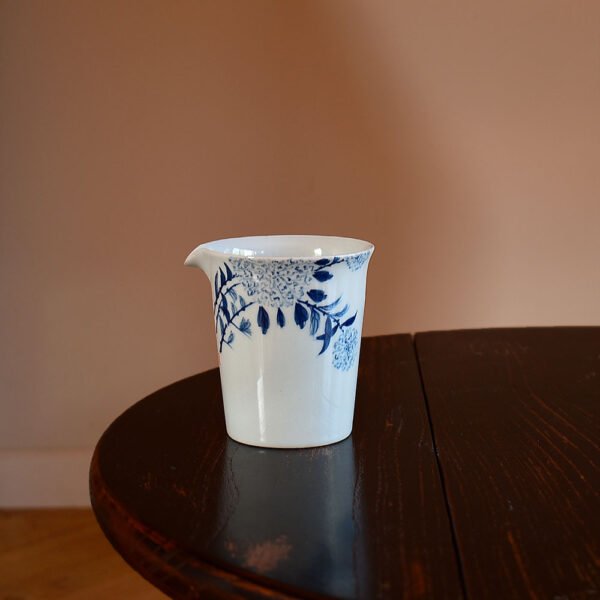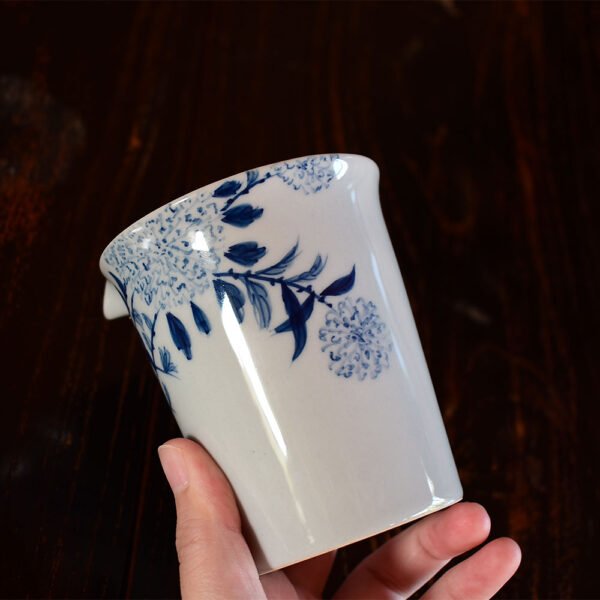Earn points when you:
Jingdezhen Teaware
- 129 Chinese Tea
Product Filters
Filter by Category
Filter by Pu-erh Type
Filter by Type
Filter by Taste
Filter by Origin
Filter by Caffeine Level
Filter by Leaf Form
Filter by Brand
Filter by Colour
Filter by Material
Filter by Number of Pieces
Filter by Colour
Filter by Material
Filter by Size
Filter by Colour
Filter by Material
Filter by Size
Filter by Colour
Filter by Material
Filter by Size
Filter by Colour
Filter by Material
Filter by Origin
129 Products
-

 $79.99
$79.99This famille rose yellow glaze aroma cup featuring the “Jade Rabbit Looking at the Moon” pattern is a beautiful piece that combines traditional Chinese artistry with exquisite craftsmanship.
Design and Appearance
- Shape Characteristics: Aroma cups are typically more slender than regular teacups. This design helps retain heat and release the tea’s aroma slowly, allowing the drinker to savor the subtle differences in the fragrance of various tea types over a longer period.
- Pattern: The aroma cup is adorned with the “Jade Rabbit Looking at the Moon” motif, depicting two white rabbits gazing up at a full moon surrounded by flowing green bamboo leaves, creating a serene and poetic scene.
- Color: The surface of the aroma cup is covered with a bright yellow glaze that is rich and vibrant in color. The use of famille rose technique brings the overglaze painting to life, making it vivid and full of charm.
Craftsmanship and Techniques
- Yellow Glaze: The use of yellow glaze is a special technique in Chinese porcelain art. It involves applying a yellow pigment over the ceramic body before firing it in the kiln. This process gives the teapot its striking and vibrant yellow color.
- Famille Rose: Famille rose, or “fencai” in Chinese, is a type of overglaze decoration. This technique uses a palette of soft and delicate colors that are painted over the glaze and then fired at a lower temperature. The famille rose technique is evident in the detailed depiction of the rabbits, the moon, and the bamboo leaves, which are finely painted with soft and harmonious colors.
Symbolism and Cultural Significance
The meaning of “The Jade Rabbit Looking at the Moon” primarily expresses deep longing for loved ones. This meaning originates from an ancient mythological story where the jade rabbit requests to reside in the Moon Palace to accompany Chang’e, thus creating the image of the jade rabbit looking at the moon. This story not only showcases the jade rabbit’s kindness and care for family but also reflects the ancients’ emphasis on family and kinship. In traditional Chinese culture, “The Jade Rabbit Looking at the Moon” is not only a symbol of the Mid-Autumn Festival but also an important cultural element for expressing longing and the desire for reunion.
The Jade Rabbit Looking at the Moon aroma teacup embodies the richness of traditional Chinese culture and poetic beauty. It is not only a practical tea ware but also a beautiful decorative piece that can be cherished and admired.
-

 $38.99
$38.99Design and Appearance
- Shape: This tasting cup adopts a classic traditional shape. The body is full and rounded, offering a comfortable grip that combines aesthetics with practicality.
- Glaze Color: The surface of the tasting cup is covered with aurora blue glaze, presenting a rich color variation. From deep blue to light white, it resembles the aurora dancing in the night sky, giving a sense of tranquility and mystery. The glaze is smooth like jade, with a warm luster.
Craftsmanship and Techniques
- Kiln Change Technique: Utilizing traditional kiln change techniques, each cup’s glaze color and texture are unique. The kiln change process creates natural color flows and textures due to high-temperature variations during firing, giving each cup its unique artistic charm.
- Aurora Blue Glaze: Aurora blue glaze is a special glaze color formed through multiple high-temperature firings. It has rich, layered colors, high gloss, a delicate and warm feel, and stable, fade-resistant colors.
Usage and Functionality
- Tasting Experience: This aurora blue tasting cup not only has an elegant appearance but also enhances your tea tasting experience. The design and glaze color complement each other, making the tea’s color more appealing and its aroma richer. It is suitable for tasting various high-quality teas, especially highly aromatic ones.
- Collection and Display: As a fine item in tea ware collections, this tasting cup is elegant whether for personal use or as a gift. Its unique glaze color and exquisite craftsmanship make it not only a practical tea ware but also a valuable art piece for collection and display.
This aurora blue kiln change tasting cup combines traditional craftsmanship with modern aesthetics, showcasing unique artistic charm and practical value. It not only provides an excellent experience for tea lovers but also serves as an art piece, adding beauty and joy to life.
Attention:
- Kiln-fired glaze variations are often unpredictable and can result in a wide range of colours from a single firing.
- The porosity of ceramics varies depending on the materials used, the recipe, the pressure applied, the duration of pressure, the thickness of the body, the firing temperature, and the duration of firing. Generally, the finer the porcelain, the smaller the pores, while the coarser the pottery, the larger the pores.
- Since porcelain is made from clay, the amount of iron spots present in the clay varies depending on the mineral content of the soil. These iron spots are harmless and do not affect the use of the porcelain. Removing them would require the use of chemical materials, which can be damaging to high-quality porcelain.
- Handmade products are not perfect, and each piece can have differences in size, shape, colour, and other aspects.
-

 Out of Stock
$33.99
Out of Stock
$33.99This teacup is baked by firewood and is made by both of kiln-fired glaze variations and cracked glaze craft. Because kiln alteration techniques enable an exciting and dynamic way to create different blue colour glazes on this teacup, each teacup is unique and made by hand, with no two being exactly alike. The phenomenon of crystal formation caused by kiln altered in a cup, commonly known as “crystal flowers”.
Besides that, the unique cracked glaze technique used creates beautiful patterns on the cup’s surface. Over time as it is soaked with tea soup, and then resulting variations in the pattern make each piece truly outstanding and add more enjoyment to the tea drinking experience.
It has:
- Unique Appearance: The master cup features a simple and elegant design with smooth lines and a rounded rim. The surface displays a soy-colored kiln-altered effect, with naturally transitioning colors and rich glaze variations, offering a visual delight.
- High-Temperature Kiln Altered Technique: This master cup is made using traditional high-temperature kiln-altered techniques. The prolonged high-temperature firing process creates unique glaze colors and textures. Each cup has a one-of-a-kind kiln-transmutation effect, making it an irreplaceable piece of art.
- Exquisite Handcraftsmanship: The master cup is handcrafted by experienced artisans, with every detail meticulously polished. The cup body is smooth and delicate, providing a comfortable grip, making it both practical and beautiful.
- Strong Practicality: This master cup is not only aesthetically pleasing but also highly practical. Its moderate capacity is perfect for enjoying tea, allowing the full release of the tea’s aroma and flavor. The rounded rim provides a comfortable drinking experience.
- Cultural Symbolism: The soy-colored kiln-altered patterns on the cup body are not only beautiful but also embody the natural imagery of traditional Chinese culture, symbolizing tranquility and harmony. This cultural element adds profound cultural significance to the master cup.
- Combination of Aesthetics and Function: This master cup is suitable for both daily use and as a collectible art piece. Its unique aesthetic design and practical functionality enhance the tea-drinking experience while also serving as a decorative item to beautify living spaces.
Attention:
- Kiln-fired glaze variations are often unpredictable and can result in a wide range of colours from a single firing.
- The porosity of ceramics varies depending on the materials used, the recipe, the pressure applied, the duration of pressure, the thickness of the body, the firing temperature, and the duration of firing. Generally, the finer the porcelain, the smaller the pores, while the coarser the pottery, the larger the pores.
- Since porcelain is made from clay, the amount of iron spots present in the clay varies depending on the mineral content of the soil. These iron spots are harmless and do not affect the use of the porcelain. Removing them would require the use of chemical materials, which can be damaging to high-quality porcelain.
- Handmade products are not perfect, and each piece can have differences in size, shape, colour, and other aspects.
-
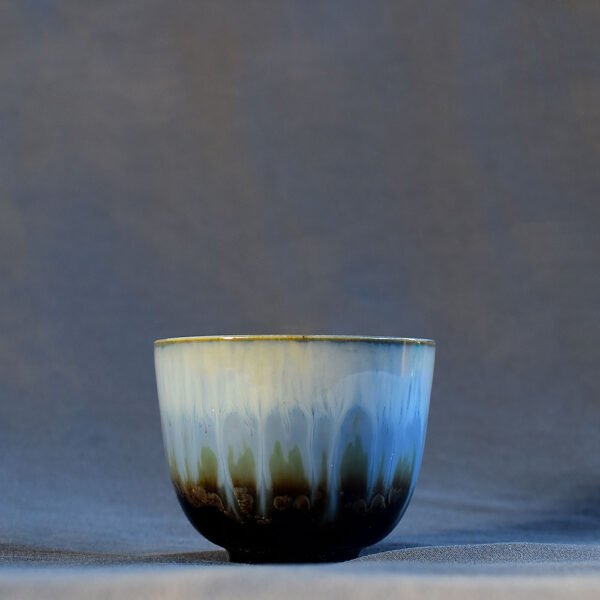
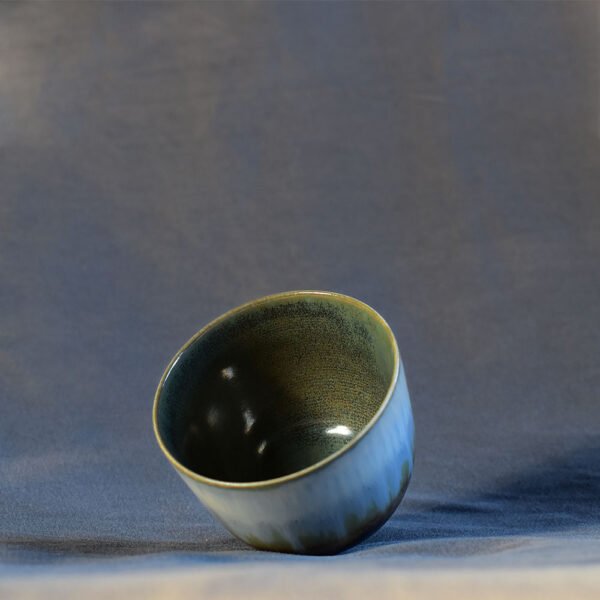 Out of Stock
$33.99
Out of Stock
$33.99This teacup is baked with firewood and is made of both kiln-fired glaze variations and cracked glaze craft. Because kiln alteration techniques enable an exciting and dynamic way to create different blue colour glazes on this teacup, each teacup is unique and made by hand, with no two being exactly alike. The phenomenon of crystal formation is caused by kiln altered in a cup, commonly known as “crystal flowers”.
Besides that, the unique cracked glaze technique used creates beautiful patterns on the cup’s surface. Over time as it is soaked with tea soup, then resulting variations in the pattern make each piece truly outstanding and add more enjoyment to the tea drinking experience.
Attention:
- Kiln-fired glaze variations are often unpredictable and can result in a wide range of colours from a single firing.
- The porosity of ceramics varies depending on the materials used, the recipe, the pressure applied, the duration of pressure, the thickness of the body, the firing temperature, and the duration of firing. Generally, the finer the porcelain, the smaller the pores, while the coarser the pottery, the larger the pores.
- Since porcelain is made from clay, the amount of iron spots present in the clay varies depending on the mineral content of the soil. These iron spots are harmless and do not affect the use of the porcelain. Removing them would require the use of chemical materials, which can be damaging to high-quality porcelain.
- Handmade products are not perfect, and each piece can have differences in size, shape, colour, and other aspects.
-

 $29.99
$29.99This handmade celadon chicken heart cup features a beautiful blue glaze that is created through the kiln altered baking process. During this process, the temperature and atmosphere inside the kiln are carefully controlled to produce variations in colour and texture on the surface of the pottery.
The resulting blue glaze on this cup is a stunning example of the unique and unpredictable effects that can be achieved through this ancient technique. The subtle variations in shade and texture give the cup a natural and organic feel, and the delicate chicken heart shape adds a touch of whimsy and charm.
Crafted with meticulous attention to detail, this cup is entirely handmade and one-of-a-kind. Its smooth, rounded shape feels comfortable in the hand, and the rich, blue glaze adds depth and dimension to the surface.
Attention:
- Kiln-fired glaze variations are often unpredictable and can result in a wide range of colours from a single firing.
- The porosity of ceramics varies depending on the materials used, the recipe, the pressure applied, the duration of pressure, the thickness of the body, the firing temperature, and the duration of firing. Generally, the finer the porcelain, the smaller the pores, while the coarser the pottery, the larger the pores.
- Since porcelain is made from clay, the amount of iron spots present in the clay varies depending on the mineral content of the soil. These iron spots are harmless and do not affect the use of the porcelain. Removing them would require the use of chemical materials, which can be damaging to high-quality porcelain.
- Handmade products are not perfect, and each piece can have differences in size, shape, colour, and other aspects.
-
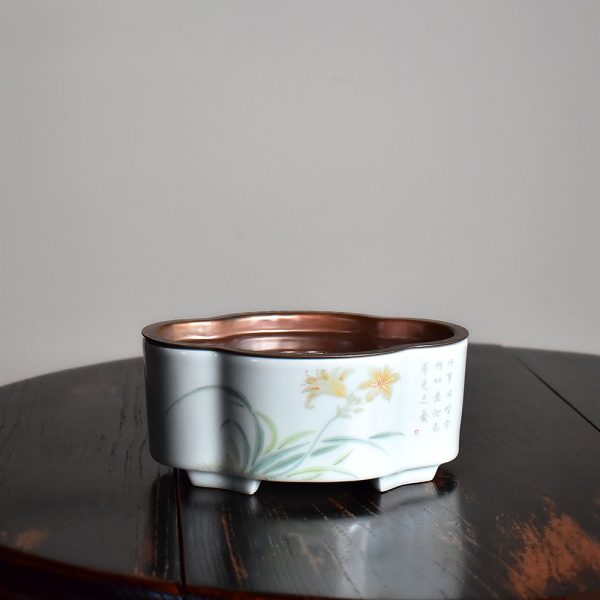
 $639.99
$639.99This Copper-Lined Hand-Painted Daylily Tea Tray features a delicate, hand-painted daylily motif, rendered in soft and elegant tones. The brushwork is refined and fluid, capturing a natural, vivid aesthetic that brings quiet charm to any tea setting. The exterior is crafted from smooth ceramic, while the inner surface is lined with copper to enhance both visual appeal and practicality. A coin-shaped drainage filter in the centre cleverly hides tea residue while allowing water to drain quickly and efficiently, marrying form and function in one thoughtful design.
Highlights:
- Hand-Painted Daylily Design: Entirely hand-painted, with graceful, flowing lines and tranquil colour tones that lend a serene, calming presence to the tea table.
- Copper Lining: The inner copper surface is durable, resistant to stains, and easy to clean, offering a premium feel and long-lasting performance.
- Coin-Shaped Drainage Hole: Rapid drainage and smart concealment of tea debris ensure a tidy surface while adding a subtle ornamental element.
- Multi-Footed Base: Stable, anti-slip, and heat-resistant structure makes it suitable for use with a variety of teapots including Yixing clay and glass teapots.
This tea tray beautifully blends functionality with artistry, making it an elegant and essential addition to any refined tea ceremony.
-

 Out of Stock
$119.99
Out of Stock
$119.99This blue and white tea set captures the tranquility of a countryside scene, depicting a poetic landscape where the sun sets and birds return home. The set includes a gaiwan, a fairness cup, and teacups, all hand-painted with traditional blue and white craftsmanship, exuding an elegant and serene oriental charm.
The gaiwan features a picturesque village nestled among rolling hills and lush trees, evoking the imagery of a peaceful retreat away from the world. The teacups complement this design, portraying distant mountain ranges, flocks of birds, and the warm glow of the setting sun, creating a harmonious and tranquil atmosphere.
The fairness cup is made of transparent glass, presenting a simple yet sophisticated contrast to the blue and white porcelain, adding depth and texture to the overall aesthetic. This thoughtfully designed tea set not only highlights the timeless beauty of traditional Chinese porcelain but also imbues tea-drinking with a poetic sense of tranquility. Whether for daily tea rituals or elegant gatherings, this set offers a peaceful and refined tea experience.
-

 $29.99Rated 5.00 out of 5
$29.99Rated 5.00 out of 5This handmade celadon chicken heart cup features a beautiful green glaze that is created through the kiln-altered baking process. During this process, the temperature and atmosphere inside the kiln are carefully controlled to produce variations in colour and texture on the surface of the pottery.
The resulting green glaze on this cup is a stunning example of the unique and unpredictable effects that can be achieved through this ancient technique. The subtle variations in shade and texture give the cup a natural and organic feel, and the delicate chicken heart shape adds a touch of whimsy and charm.
Crafted with meticulous attention to detail, this cup is entirely handmade and one-of-a-kind. Its smooth, rounded shape feels comfortable in the hand, and the rich, green glaze adds depth and dimension to the surface.
Attention:
- Kiln-fired glaze variations are often unpredictable and can result in a wide range of colours from a single firing.
- The porosity of ceramics varies depending on the materials used, the recipe, the pressure applied, the duration of pressure, the thickness of the body, the firing temperature, and the duration of firing. Generally, the finer the porcelain, the smaller the pores, while the coarser the pottery, the larger the pores.
- Since porcelain is made from clay, the amount of iron spots present in the clay varies depending on the mineral content of the soil. These iron spots are harmless and do not affect the use of the porcelain. Removing them would require the use of chemical materials, which can be damaging to high-quality porcelain.
- Handmade products are not perfect, and each piece can have differences in size, shape, colour, and other aspects.
-
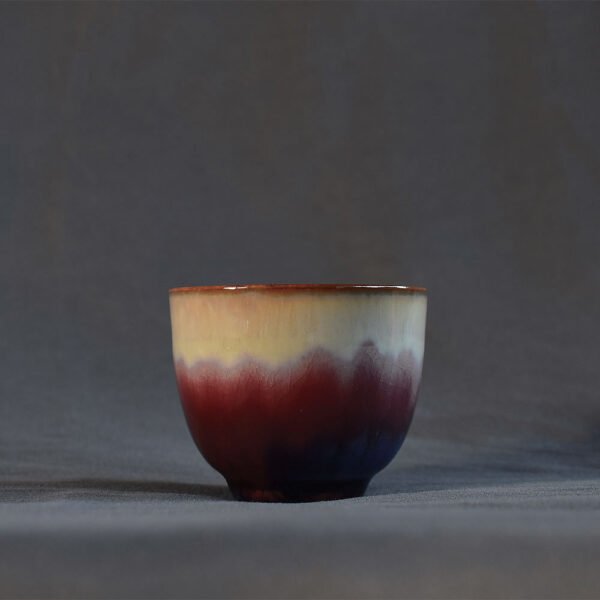
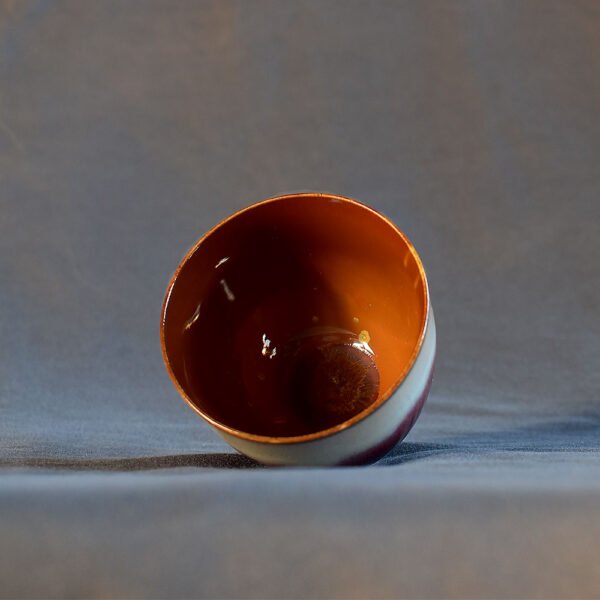 Out of Stock
$33.99
Out of Stock
$33.99This red teacup is baked with firewood and is made of both kiln-fired glaze variations and cracked glaze craft. Because kiln alteration techniques enable an exciting and dynamic way to create different red colour glazes on this teacup, each teacup is unique and made by hand, with no two being exactly alike. The phenomenon of crystal formation is caused by kiln altered in a cup, commonly known as “crystal flowers”.
Besides that, the unique cracked glaze technique used creates beautiful patterns on the cup’s surface. Over time as it is soaked with tea soup, and then resulting variations in the pattern make each piece truly outstanding and add more enjoyment to the tea drinking experience.
Attention:
- Kiln-fired glaze variations are often unpredictable and can result in a wide range of colours from a single firing.
- The porosity of ceramics varies depending on the materials used, the recipe, the pressure applied, the duration of pressure, the thickness of the body, the firing temperature, and the duration of firing. Generally, the finer the porcelain, the smaller the pores, while the coarser the pottery, the larger the pores.
- Since porcelain is made from clay, the amount of iron spots present in the clay varies depending on the mineral content of the soil. These iron spots are harmless and do not affect the use of the porcelain. Removing them would require the use of chemical materials, which can be damaging to high-quality porcelain.
- Handmade products are not perfect, and each piece can have differences in size, shape, colour, and other aspects.
-

 Out of Stock
$109.99
Out of Stock
$109.99This Gaiwan is made with antique clay glaze, which gives it a smooth and lustrous surface, as well as a thick and sturdy body, evoking a sense of ancient elegance, tranquillity, and warmth. The hand-painted pictures are lively and natural, depicting the goji berries with lifelike accuracy.
Goji berries, a small orange-red fruit with a long history in China, symbolize auspiciousness and happiness. The elongated fruits of goji berries are fiery red in color, hence in China, goji berries are regarded as a symbol of celebration and joy. The fiery red goji berries represent good luck and signify a life filled with prosperity and vitality.
Furthermore, the Gaiwan is crafted using the overglaze colour painting craft, which produces pure, vibrant, and full colours. Since Gaiwan is hand-painted by an artist, every piece is unique and machine-printed decals cannot compare with.
-
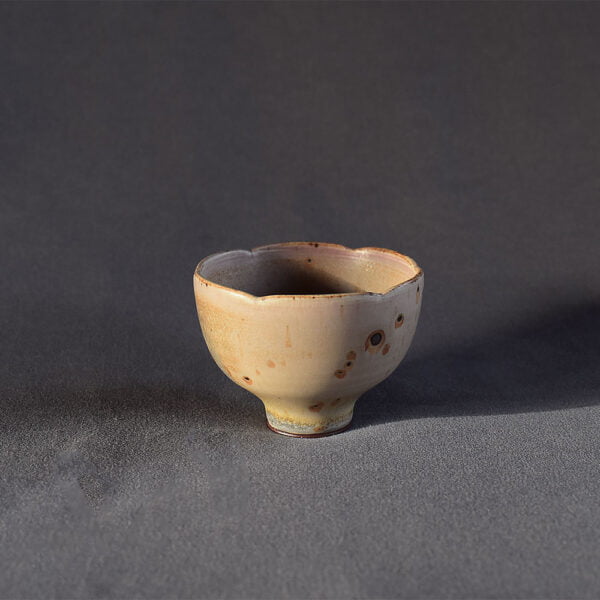
 Out of Stock
$33.99Rated 5.00 out of 5
Out of Stock
$33.99Rated 5.00 out of 5The teacup is handmade using the wood-fired kiln altered glaze technique, and its glaze presents a unique yellow and light purple colour. The phenomenon of crystal formation is caused by kiln altered in a cup, commonly known as “crystal flowers”.
The varying shades of colour make each cup one-of-a-kind, adding a rugged and beautiful charm to your tea table. The mouth of the cup is designed with a flower shape, making the whole cup look even more entertaining.
Attention:
- Kiln-fired glaze variations are often unpredictable and can result in a wide range of colours from a single firing.
- The porosity of ceramics varies depending on the materials used, the recipe, the pressure applied, the duration of pressure, the thickness of the body, the firing temperature, and the duration of firing. Generally, the finer the porcelain, the smaller the pores, while the coarser the pottery, the larger the pores.
- Since porcelain is made from clay, the amount of iron spots present in the clay varies depending on the mineral content of the soil. These iron spots are harmless and do not affect the use of the porcelain. Removing them would require the use of chemical materials, which can be damaging to high-quality porcelain.
- Handmade products are not perfect, and each piece can have differences in size, shape, colour, and other aspects.
-

 $279.99
$279.99This elegant tea set features a serene countryside design and includes a teapot with a “Meiren Jian” (Beauty Shoulder) shape, a fairness pitcher, and four tea cups. Each piece is adorned with hand-painted blue-and-white landscape patterns that depict a tranquil village scene. The flowing river, lush trees, distant houses, and soaring birds evoke a sense of natural harmony and rustic charm.
The teapot stands out with its graceful “Beauty Shoulder” design, where the soft, smooth lines of the shoulder resemble the curve of a beauty’s shoulder, exuding elegance and sophistication. The spout is naturally curved for smooth pouring, while the handle offers a comfortable grip for ease of use. The lid fits seamlessly with the teapot, ensuring that the tea’s warmth and aroma are retained, combining functionality with aesthetic appeal. The tea cups are well-proportioned, with slightly flared rims that enhance drinking comfort while adding a touch of refinement. The fairness pitcher complements the set with its simple and elegant design, creating a cohesive and harmonious style.
The deep and vibrant blue glaze contrasts beautifully with the pristine white porcelain, creating a fresh and refined visual effect. This tea set is not only a practical tool for brewing tea but also a collectible piece that blends traditional craftsmanship with artistic value. Whether for daily use or as a thoughtful gift for friends and family, it reflects both taste and a reverence for cultural heritage.
-
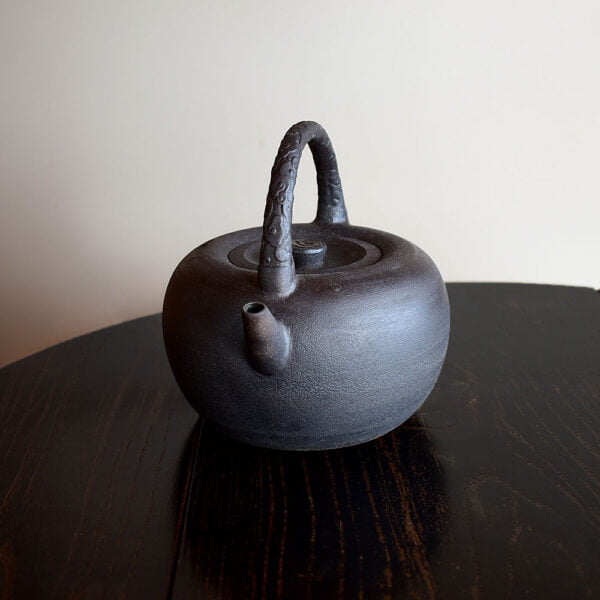
 $339.99
$339.99This teapot is made with special Lao Yan Mud as the raw material which possesses irreplaceable advantages over other clay materials for teapot making. Lao Yan Mud is formulated by blending rock minerals and clay. The mineral components (such as quartz, mica, etc) in the clay do not melt at temperatures around 1250 degrees Celsius, resulting in the formation of voids during the firing and drying process. These irregular pores, formed due to different shrinkage rates during the final firing, do not fully vitrify. These porous structures contribute to preserving and enhancing the aroma and character of tea, allowing the water to become fragrant and sweet when brewed. This special mud undergoes multiple high-temperature oxidations and reductions, causing its body to exhibit a primitive, natural, and rugged texture. Its colour displays a myriad of kiln-fired variations, exuding a charming and rustic kiln transformation.
In addition, this teapot’s handle is adorned with auspicious cloud patterns. In ancient China, firstly, auspicious clouds symbolize good fortune and positivity. In traditional Chinese culture, auspicious clouds are often depicted surrounding figures of immortals, sages, and auspicious beings, signifying good luck, happiness, and blessings. Secondly, auspicious clouds also represent power and status. In ancient times, the emperor’s outings were often described with imagery like ‘dragon robes, golden belt, purple tassels, and auspicious clouds,’ expressing the emperor’s prestigious position and authority. Thus, auspicious clouds are also regarded as a symbol of power and status. Furthermore, auspicious clouds also embody the notions of mystery and legend. In ancient legends, auspicious clouds were believed to be the mounts of immortals and celestial beings, serving as bridges to the heavens. The emperor’s journeys were often accompanied by an air of mystery and legend. In short, auspicious clouds hold a significant place in traditional Chinese culture, representing auspiciousness, power, mystery, and legend. They are widely prevalent and important motifs and elements in various aspects of Chinese art such as painting, sculpture, architecture, and literature.
The appearance of this teapot is rustic and simple, with lifelike auspicious cloud patterns on the handle, making it a perfect companion for tea brewing.
-
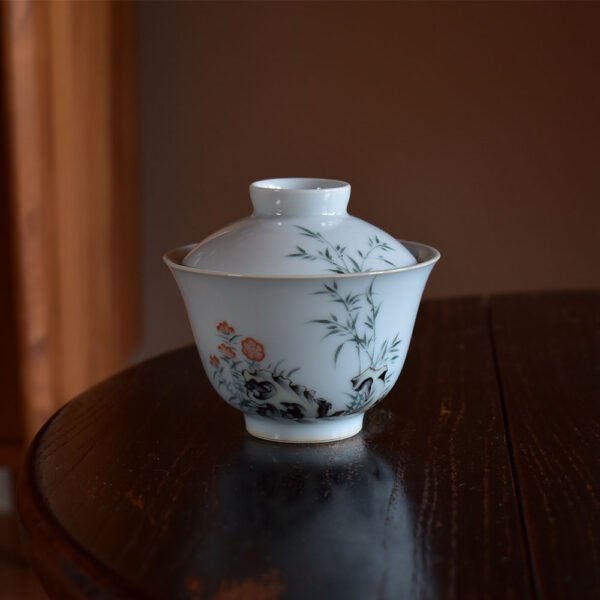
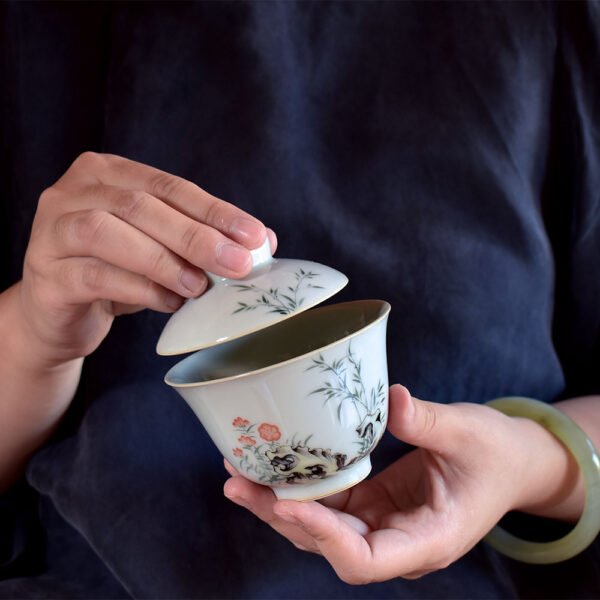 $113.99Rated 5.00 out of 5
$113.99Rated 5.00 out of 5This Gaiwan is made with antique clay glaze, which gives it a smooth and lustrous surface, as well as a thick and sturdy body, evoking a sense of ancient elegance, tranquillity, and warmth. The hand-painted strokes are lively and natural, depicting the bamboo forest and rocks with lifelike accuracy.
The Chinese bamboo forest and rocks have profound symbolic meanings in culture and art. The bamboo forest symbolizes resilience and humility. Bamboo is known for its strong vitality and flexible nature, able to withstand harsh winters and remain upright. This characteristic has made bamboo a symbol of traditional virtues in China, including perseverance, resilience in adversity, and modesty. Additionally, the bamboo forest is often seen as a place of seclusion, representing the pursuit of inner freedom and tranquillity. Rocks, on the other hand, symbolize stability and steadfastness. In Chinese art, rocks are frequently depicted as rugged, majestic, and serene. They represent the eternal and unchanging aspects of the natural world, as well as the values of determination and stability that people strive for in life. Rocks are also seen as symbols of wisdom and longevity, standing tall and unwavering despite the passage of time.
Furthermore, the Gaiwan is crafted using the overglaze colour painting craft, which produces pure, vibrant, and full colours. Since Gaiwan is hand-painted by an artist, every piece is unique and machine-printed decals cannot be compared with.
-
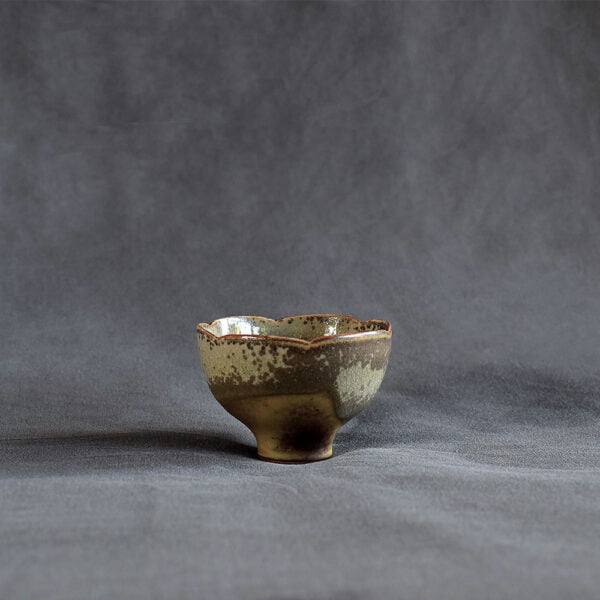
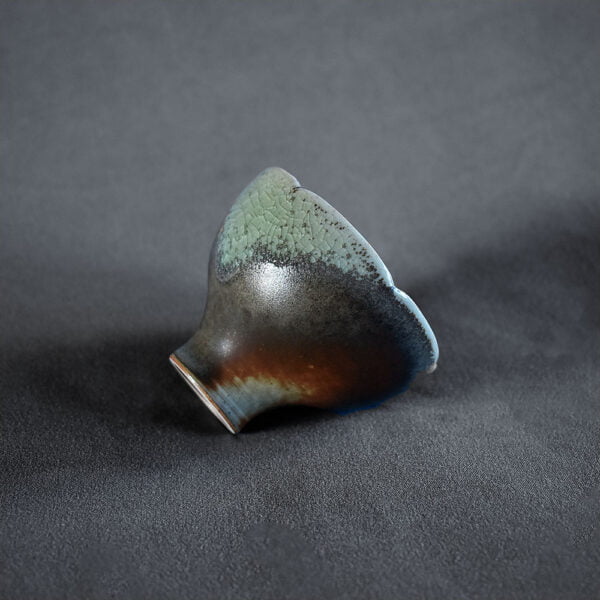 Out of Stock
$33.99
Out of Stock
$33.99The teacup is handmade using the wood-fired kiln-altered glaze technique, and its glaze presents a unique green colour. The phenomenon of crystal formation is caused by a kiln altered in a cup, commonly known as “crystal flowers”.
The varying shades of colour make each cup one-of-a-kind, adding a rugged and beautiful charm to your tea table. Its design features a high foot and a small base, which give it a delicate appearance. The mouth of the cup is designed with a flower shape, making the whole cup look even more entertaining.
Attention:
- Kiln-fired glaze variations are often unpredictable and can result in a wide range of colours from a single firing.
- The porosity of ceramics varies depending on the materials used, the recipe, the pressure applied, the duration of pressure, the thickness of the body, the firing temperature, and the duration of firing. Generally, the finer the porcelain, the smaller the pores, while the coarser the pottery, the larger the pores.
- Since porcelain is made from clay, the amount of iron spots present in the clay varies depending on the mineral content of the soil. These iron spots are harmless and do not affect the use of the porcelain. Removing them would require the use of chemical materials, which can be damaging to high-quality porcelain.
- Handmade products are not perfect, and each piece can have differences in size, shape, colour, and other aspects.
-
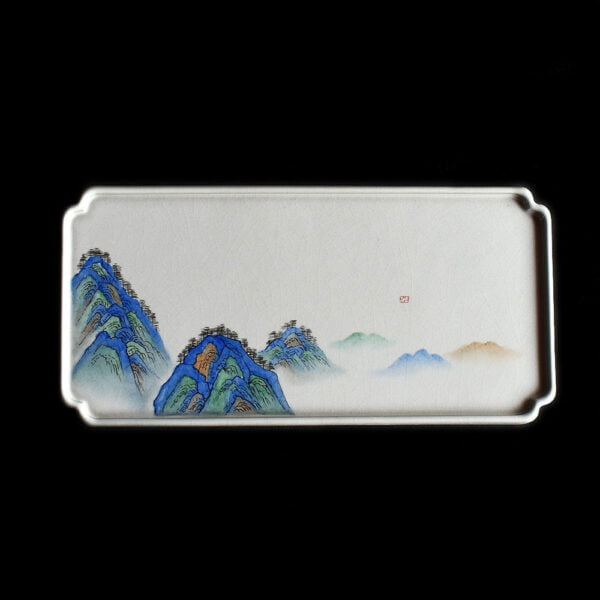
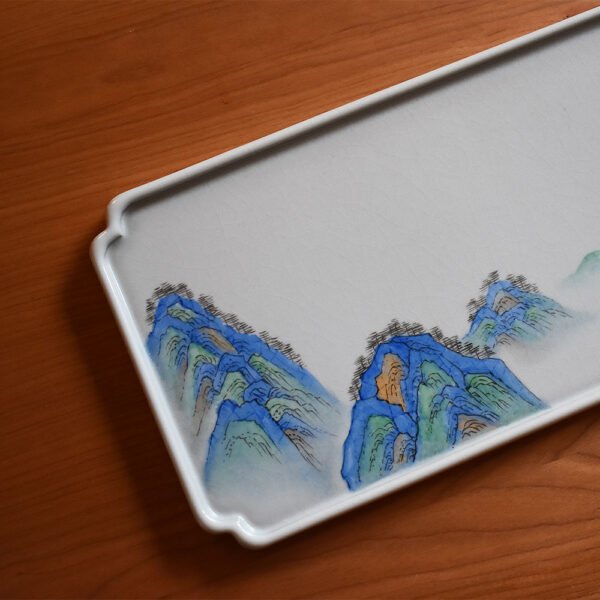 Out of Stock
$135.99
Out of Stock
$135.99This tea tray is handcrafted using the Ru Klin technique. The painting features a depiction of mountain scenery in shades of blue and green. The Ru porcelain glaze is thick and often exhibits crackling patterns resembling fish scales or cicada wings. With prolonged use, tea soup can seep into the cracks, forming irregular and intricate patterns. As a result, the surface feels smooth and polished, reminiscent of the beauty of jade yet distinct from actual jade.
-

 Out of Stock
$99.99
Out of Stock
$99.99This tea tray is handcrafted using the Ru Klin technique. The painting features a cute kitty on the stone. The Ru porcelain glaze is thick and often exhibits crackling patterns resembling fish scales or cicada wings. With prolonged use, tea soup can seep into the cracks, forming irregular and intricate patterns. As a result, the surface feels smooth and polished, reminiscent of the beauty of jade yet distinct from actual jade.
-
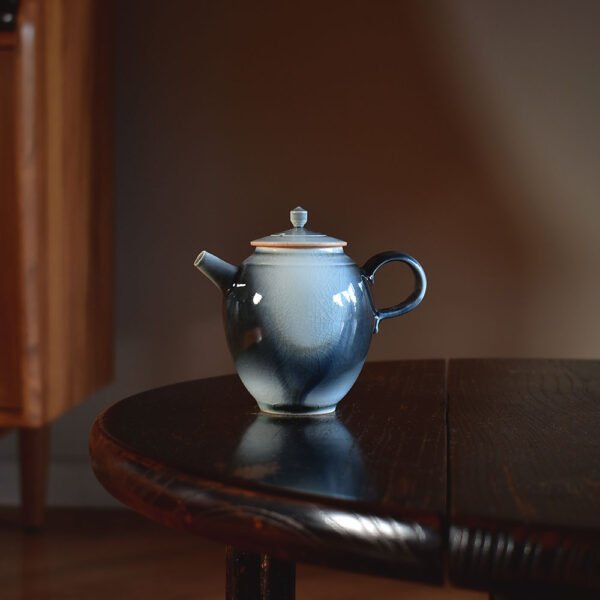
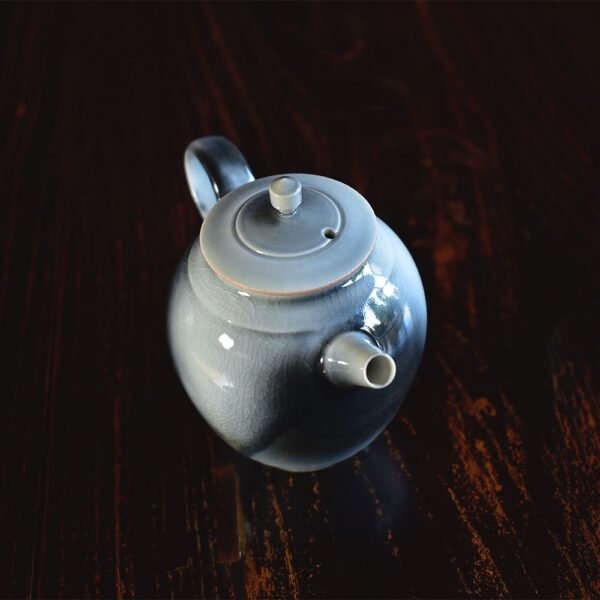 Out of Stock
$143.99
Out of Stock
$143.99This small teapot is made by both kiln-fired glaze variations and cracked glaze craft. Because kiln alteration techniques enable an exciting and dynamic way to create different red colour glazes on this teacup, each teacup is unique and made by hand, with no two being exactly alike. The phenomenon of crystal formation is caused by a kiln altered in a cup, commonly known as “crystal flowers”.
Besides that, the unique cracked glaze technique used creates beautiful patterns on the cup’s surface. Over time as it is soaked with tea soup, and the resulting variations in the pattern make each piece truly outstanding and add more enjoyment to the tea-drinking experience.
Attention:
- Kiln-fired glaze variations are often unpredictable and can result in a wide range of colours from a single firing.
- The porosity of ceramics varies depending on the materials used, the recipe, the pressure applied, the duration of pressure, the thickness of the body, the firing temperature, and the duration of firing. Generally, the finer the porcelain, the smaller the pores, while the coarser the pottery, the larger the pores.
- Since porcelain is made from clay, the amount of iron spots present in the clay varies depending on the mineral content of the soil. These iron spots are harmless and do not affect the use of the porcelain. Removing them would require the use of chemical materials, which can be damaging to high-quality porcelain.
- Handmade products are not perfect, and each piece can have differences in size, shape, colour, and other aspects.
-
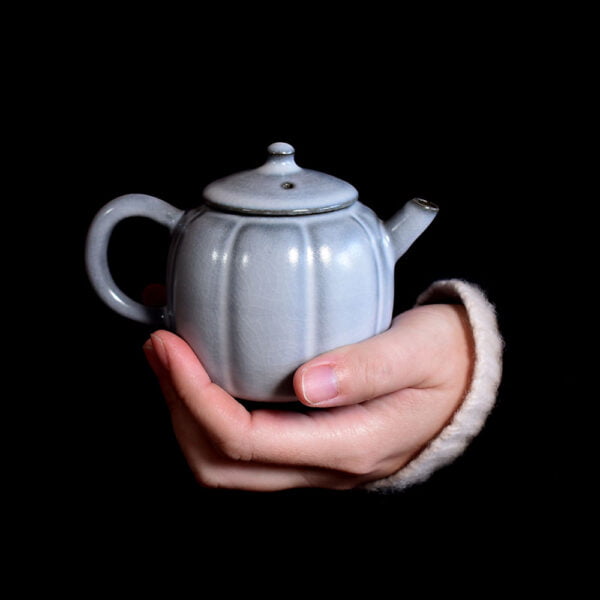
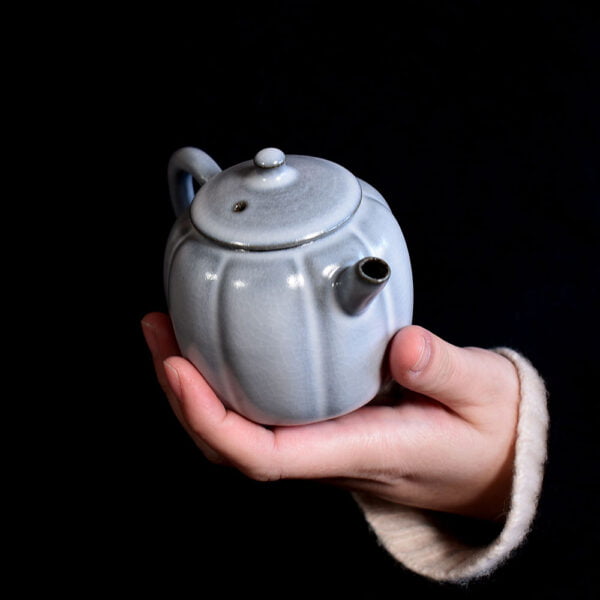 Out of Stock
$439.99
Out of Stock
$439.99This teapot is made with special Lao Yan Mud as the material, both inside and outside covered with soda ash glaze, and semi-handmade. Its elegant shape and smooth water flow make it an excellent companion for tea drinking. The unique cracked glaze technique creates beautiful patterns on the surface as the cracks are formed by the long-term infusion of tea. Generally, the patterns created through the cracked glaze technique are unique, adding more enjoyment to the tea brewing process.
Its special clay material, Lao Yan Mud, possesses irreplaceable advantages over other clay materials for teapot making. Lao Yan Mud is formulated by blending rock minerals and clay. The mineral components (such as quartz, mica, etc) in the clay do not melt at temperatures around 1250 degrees Celsius, resulting in the formation of voids during the firing and drying process. These irregular pores, formed due to different shrinkage rates during the final firing, do not fully vitrify. These porous structures contribute to preserving and enhancing the aroma and character of the tea, allowing the water to become fragrant and sweet when brewed.
Besides the special mud, soda glaze is another main character of this tea pot. The soda glaze is crafted using imported raw minerals from Japan, where, through high-temperature firing, weak alkaline metal ions such as potassium, sodium, and calcium are released and incorporated into the glaze. The surface of the teapot bears tiny pores left behind by the firing process of the natural raw minerals. These breathable pores possess the unique ability to adsorb tea impurities, reduce bitterness, and maintain a refreshing, non-stuffy character, greatly enhancing the quality of the tea infusion. The result is a smoother, more delicate, and pleasantly aromatic tea experience. Upon heating with boiling water, the trace elements like boron, zinc, and lithium, found within the soda glaze, significantly soften the water quality. This effect causes the water molecules to exhibit a weak alkaline state, a characteristic not typically found in ordinary boiling vessels. This outstanding property has earned it the industry nickname – ‘the balance of regulating the body’s acid-alkaline equilibrium.’ Prolonged use of the soda-glazed miniature teapot proves highly beneficial for one’s health.
This teapot has a simple, rustic appearance and smooth water flow. Due to the spongy pores of the Lao Yan mud which makes it can absorb the fragrance of the tea leaves, the aroma of the tea soup can easily maintain for a longer time and taste smoother and sweeter.
-

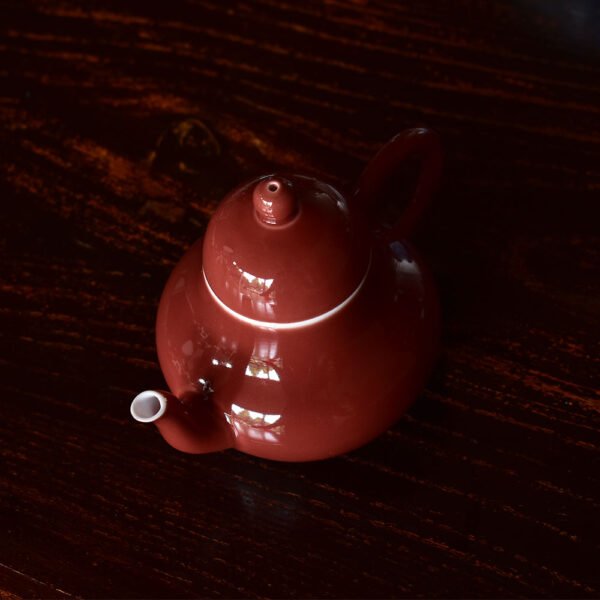 Out of Stock
$45.99
Out of Stock
$45.99This teapot is made with an iron red glaze which make it looks warm and earthy, glossyand smooth. The main component of this special glaze is iron-containing minerals, such as hematite and ochre. In the production of ceramics, these minerals are mixed with other raw materials and then high temperature fired to form a hard glaze surface.
The teapot with an iron red glaze would be a beautiful and practical addition to any tea lover’s collection, with a timeless appeal that speaks to the rich history and tradition of ceramic art.
-
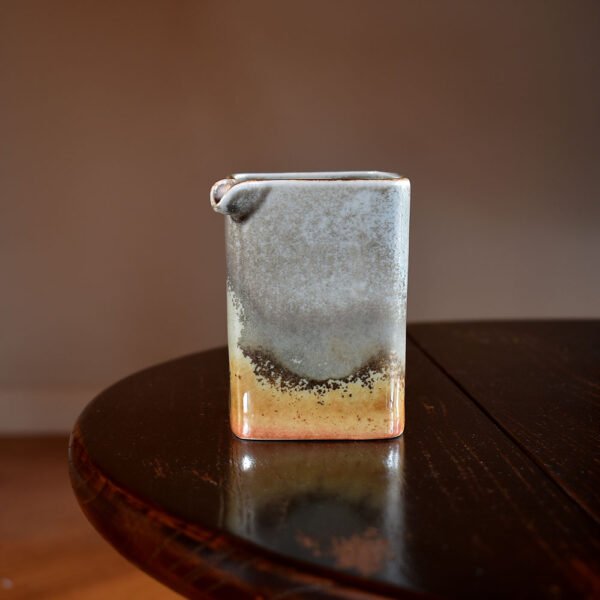
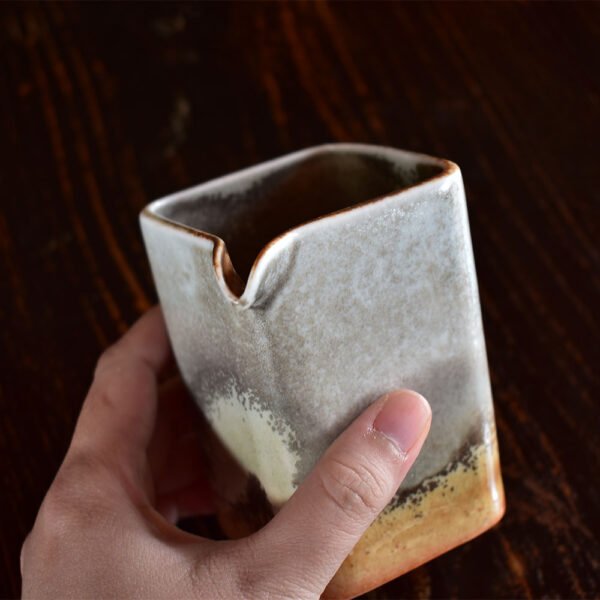 $68.99
$68.99This fair cup is baked with firewood and is made by both kiln-fired glaze variations and cracked glaze craft. Each one is unique and made by hand, with no two being exactly alike.
The square and simple shape of the cup allows for smooth pouring. The unique cracked glaze technique used creates beautiful patterns on the cup’s surface. Over time as it is soaked with tea soup, resulting variations in the pattern make each piece truly outstanding and add more enjoyment to the tea-drinking experience.
Attention:
- Kiln-fired glaze variations are often unpredictable and can result in a wide range of colours from a single firing.
- The porosity of ceramics varies depending on the materials used, the recipe, the pressure applied, the duration of pressure, the thickness of the body, the firing temperature, and the duration of firing. Generally, the finer the porcelain, the smaller the pores, while the coarser the pottery, the larger the pores.
- Since porcelain is made from clay, the amount of iron spots present in the clay varies depending on the mineral content of the soil. These iron spots are harmless and do not affect the use of the porcelain. Removing them would require the use of chemical materials, which can be damaging to high-quality porcelain.
- Handmade products are not perfect, and each piece can have differences in size, shape, colour, and other aspects.
-

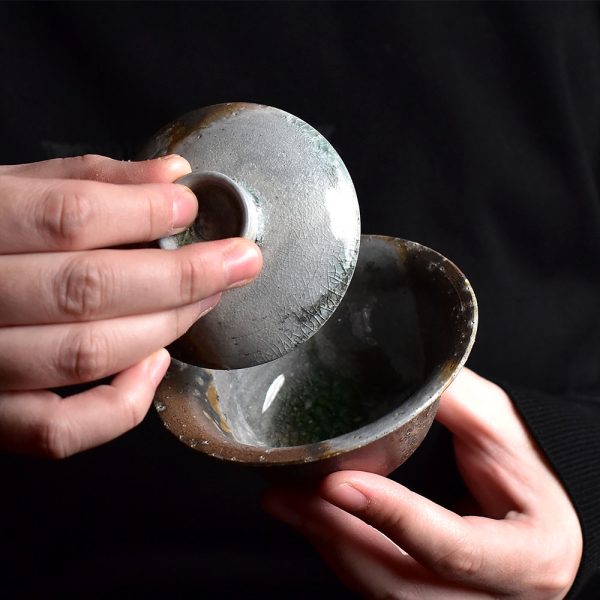 $679.99
$679.99This Gaiwan is crafted using the authentic wood-fired, unglazed technique. Without any applied glaze, the surface develops naturally as wood ash falls, melts, and flows during the high-temperature firing, creating rich layers of color. The outer wall bears fire marks of grey-black, milky white, brown, and ochre, with subtle kiln variations that resemble the weathered texture of ancient stone.
The most distinctive feature is the pine frost-like bluish-green vitrified crystallisation inside the bowl. This cool green tone is formed as minerals from the wood ash melt and crystallise under intense heat and a reducing atmosphere. Between the crystals lie natural crackle patterns, their glossy brilliance echoing the bowl’s milky-white tones, evoking the image of frost settling upon pine branches in winter—pure, serene, and alive.
Portions of the inner surface show a pronounced vitrified effect. During firing, as the temperature rises, components within the clay and ash gradually melt, forming a glass-like glaze layer. Vitrification gives the interior surface its hardness and smoothness, while enhancing both texture and utility. The essence of wood-firing lies in its irreproducibility: flame paths, ash deposits, and cooling rhythms together shape the unique character of each vessel.
Named Pine Forest, this Gaiwan conveys both the cool bluish-green tones within and the natural elegance of wood-fired ware. Rugged yet refined, rustic yet graceful, it embodies a balance of artistry, beauty, and collectible value.
-

 $679.99
$679.99This Gaiwan is crafted using the authentic wood-fired, unglazed technique. Without the application of glaze, the surface develops naturally as wood ash falls, melts, and flows during high firing, leaving behind an organic glaze layer and traces of fire. The exterior displays an interplay of dark brown, ochre, grey, and mossy green tones, while the lid and bowl are marked with striking flame-swept patterns, resulting in an unrepeatable beauty unique to each firing.
Inside the bowl, parts of the surface show a distinct vitrified effect. During firing, as the temperature rises to a certain level, minerals in the clay and ash partially melt, forming a glass-like glaze layer. This vitrified surface is glossy, dense, and durable, with natural traces of flowing ash glaze. Vitrification not only enhances the shine and texture of the gaiwan but also strengthens the vessel, improving its resistance to wear and corrosion.
The charm of wood-firing lies in the principle of “one piece, one world.” Every firing is a dialogue with flame, ash, temperature, and atmosphere, and the final result is always one of a kind. Each wood-fired Gaiwan carries the joint creation of nature and fire—raw and primal, yet elegant and refined—holding both artistic and collectible value.
-

 $229.99
$229.99This tasting cup is made using the authentic wood fired unglazed technique. Without any applied glaze, the surface is shaped naturally as wood ash falls, melts, and flows during the high temperature firing, giving rise to colors and textures that cannot be replicated. The outer wall reveals fire marks of grey black, ochre and rust brown, with a rugged yet natural texture reminiscent of stone and earth weathered over time, which inspired the name aged earth tone.
The interior displays striking kiln effects, where layers of yellow and brown melted ash glaze emerged naturally during the firing. Some areas exhibit a vitrified surface, glossy and smooth, with light and dark contrasts that add depth. The collaboration between fire and wood ash creates rich layers of color, evoking mineral veins buried deep within the earth, rustic yet profound.
The essence of wood firing lies in its irreproducibility. The path of the flames, the settling of ash, and the pace of cooling all shape the individuality of each piece. Every cup is a creation of both fire and nature, balancing raw strength with quiet refinement, and rustic charm with graceful elegance.
This wood fired aged earth tone tasting cup is not only a vessel for daily tea drinking but also a unique work of art with lasting collectible value.
-

 $229.99
$229.99This tasting cup is made using the authentic wood fired unglazed technique. Without any applied glaze, the surface develops naturally as wood ash falls, melts, and flows during the high temperature firing, creating rich layers of color. The outer wall shows fire marks of grey black, milky white, brown and ochre, with delicate kiln variations that resemble the calm texture of stone weathered over time.
The most distinctive feature is the bluish green vitrified crystallisation formed inside the cup, reminiscent of pine frost. This cool green tone is created as minerals in the wood ash melt and crystallise under intense heat and a reducing atmosphere. Between the crystals lie natural crackle patterns, glossy and bright, evoking frost on pine branches in winter, serene and vivid.
Parts of the inner surface show a clear vitrified effect. During firing, as the temperature rises, components within the clay and ash gradually melt, forming a glass like glaze layer. Vitrification makes the surface harder and smoother, while enhancing both texture and usability. The essence of wood firing lies in its irreproducibility: flame paths, ash deposits and cooling rhythms together shape the unique character of this cup.
Named Pine Forest, it conveys its cool bluish green tones and the natural elegance of wood fired ware. Rugged yet refined, rustic yet graceful, it holds both artistic beauty and collectible value.
-
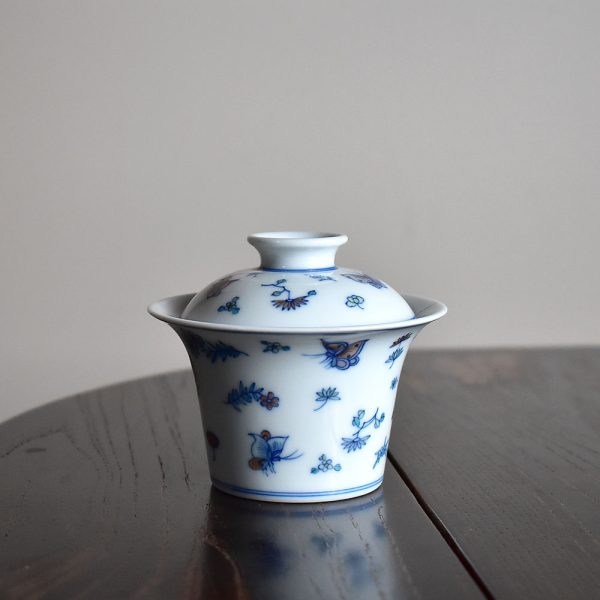
 Out of Stock
$739.99
Out of Stock
$739.99This exquisite Gaiwan from Jingdezhen showcases the traditional Doucai technique, featuring a unique horseshoe-shaped body. The flared rim and flowing lines create an elegant silhouette that fits naturally in the hand—comfortable to hold, heat-insulated, and aesthetically refined.
The piece is themed around the classic motif ‘Butterfly Loves the Flower’ with hand-painted butterflies fluttering gracefully among swaying floral branches. The composition is airy and poetic, expressing an ethereal charm. In Chinese culture, this motif has long symbolised romantic love, freedom of the soul, and vitality. In classical poetry and art, butterflies often represent delicate emotions and mutual affection, while flowers signify beauty and ideal moments—together, they portray love’s longing and fulfilment.
Crafted using the Doucai method—an imperial decorative style originating in the Ming Dynasty’s Chenghua period—the process is intricate. First, outlines are painted in underglaze cobalt blue and fired at high temperature. Then, overglaze enamels are applied to add colour before a second low-temperature firing. The result is a harmonious interplay of subdued blue and vibrant enamel tones, with rich layers and refined softness. Doucai is celebrated as a pinnacle of Chinese ceramic artistry, known for its elegance and depth.
The Gaiwan’s lid, bowl, and saucer are proportioned with precision. The gently rounded rim is smooth to the touch and slightly flared to prevent burns, offering a pleasant handling experience. This Doucai Gaiwan is not only a functional teaware piece but also a collectible artwork steeped in cultural and aesthetic significance—ideal for daily tea sessions, refined tea tables, or as a meaningful gift.
Whether enjoyed in solitary serenity or shared with friends, it brings a touch of poetic grace to each moment of tea.
-

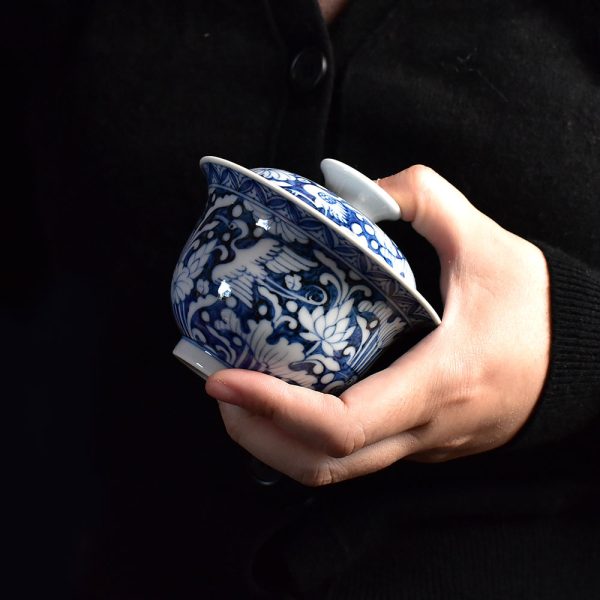 $698.99
$698.99This Gaiwan is made in the style of the Yuan dynasty blue and white porcelain, completely handmade and hand painted. The pattern of “一鹭莲科” or “一路连科” in Chinese culture is derived from the beautiful combination of the heron and lotus leaves. As “鹭” (heron) and “路” (path/road) have the same pronunciation, and “莲” (lotus) sounds like “连” (successive/continuous), the name “一路连科” is a play on words that conveys the beautiful meaning of the pattern. In ancient times, successive successful candidates in the imperial examinations were called “连科,” and “一路连科” is a good wish for students to have a smooth career path and achieve success step by step.
For Yuan blue and white porcelain refers to the blue and white porcelain produced during the Yuan dynasty (1271-1368) in China. The Yuan dynasty was an important period in the history of Chinese porcelain and one of the peaks of Chinese porcelain art. As one of the representatives of that era, Yuan blue and white porcelain exhibited unique artistic styles and technical levels. The characteristic of Yuan blue and white is the use of cobalt blue pigment for painting, which is made of cobalt oxide. After firing, the colour is bright and rich, with extremely high decorative effect. Yuan blue and white porcelain has various shapes, thick and heavy, concise, and fluent lines, and stable and solemn shapes, all made exquisitely.
The evolution of Yuan blue and white is based on the foundation of Tang and Song celadon. Firstly, the glaze colour was improved and innovated. Unique white glaze, eggshell glaze and blue-white glaze were invented to make the glaze crystal clear. Cobalt pigment was imported for glaze colouring. Or using the pigment made from domestic materials.
The formation of tin spots on Yuan blue and white is due to the high content of iron elements in local parts of the blue pigment. After reaching saturation in the high-temperature glaze solution and cooling down, the iron elements in the supersaturated part start to precipitate. If the iron content of the blue pigment is higher and the cooling rate is appropriate, tin spots are more likely to appear on the surface of the ware.
In addition to firing and materials, the formation of tin spots also involves the factor of glaze material. During the painting process, tin spots can also be formed due to the accumulation of blue pigment. Tin spots are more likely to appear on the surface of the ware at the intersections and the starting and ending points of brushstrokes. The formation of tin spots can be said to be a natural creation or an artificial decoration.
While this Lian Sheng Yuan Xi Gaiwan retains the bold and rich coloration of classic Yuan blue and white porcelain, its tin-spot effect is relatively subtle, giving it a more delicate and refined appearance. The overall aesthetic is graceful and elegant, embodying a scholarly charm. Compared to the traditionally bold and unrestrained Yuan blue and white style, this piece leans towards a more understated and sophisticated aesthetic, blending classic heritage with a softer, more literary elegance. It brings a sense of warmth and refinement to any tea session, offering a harmonious balance between history and artistry.
-

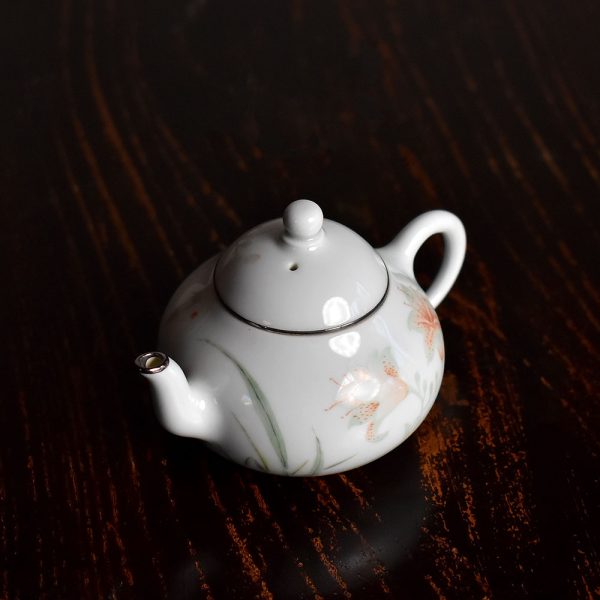 $699.99
$699.99This hand-painted daylily teapot with silver-rimmed spout is crafted from traditional Jingdezhen porcelain. The exterior is adorned with elegant daylily motifs, delicately rendered with soft and natural brushwork. It features the classic Famille Rose (fencai) technique—an imperial Qing dynasty overglaze enamel tradition. By mixing pigments with lead white (commonly known as “glassy white”), the resulting colours are warm, refined, and layered, offering a serene and graceful aesthetic rooted in classical Chinese artistry.
The rim of the teapot is reinforced with a finely applied silver band, which not only enhances the visual texture and overall elegance but also provides a practical layer of protection, guarding against chipping or breakage. The harmonious pairing of silver detailing and pastel enamel gives this piece both charm and resilience.
Compact and well-balanced, the teapot fits comfortably in hand. It pours smoothly with a clean stream, making it ideal for use with fairness pitchers and small teacups during tea ceremonies. Whether for solitary enjoyment or as a thoughtful gift, it embodies both usability and artistic value.
Perfect for daily tea rituals or as a collectible, this Famille Rose Teapot with Silver Rim brings a touch of calm refinement to the tea table, gracefully echoing the quiet poetry and subtle elegance of traditional Eastern tea culture.
-

 $699.99
$699.99This Famille Rose Silver-Rimmed Peach Blossom Teapot is crafted from traditional Jingdezhen porcelain, featuring an elegant hand-painted peach blossom motif. The delicate floral patterns exhibit a natural and graceful posture, with soft and refreshing tones. Utilizing the classic Famille Rose (Fencai) technique, a prestigious decorative art from the Qing imperial court, this teapot embodies the refined aesthetics of overglaze painting. By incorporating “glass white” pigment, the colors appear warm and delicate, with a rich sense of layering and depth, highlighting the timeless elegance of oriental artistry.
The spout and rim are reinforced with a silver lining, seamlessly fitted to the ceramic surface. This not only enhances the overall texture but also serves a practical purpose—preventing chipping and damage. The silver detailing beautifully complements the Famille Rose painting, adding a touch of sophistication and antique charm.
With its compact and well-proportioned form, the teapot offers a comfortable grip and a smooth, precise pour. It pairs effortlessly with various fairness pitchers and tasting cups, making it ideal for both personal tea appreciation and refined tea ceremonies.
Whether used for daily brewing or as a collectible gift, the Famille Rose Silver-Rimmed Peach Blossom Teapot brings a sense of tranquility and warmth to any tea setting, subtly conveying the poetic beauty and serene elegance of Eastern tea culture.
-

 Out of Stock
$139.99
Out of Stock
$139.99Design and Appearance
- Shape: The gaiwan adopts the classic three-piece design, consisting of a lid, bowl, and saucer. Its shape is full and round with smooth lines, providing a comfortable grip, making it both beautiful and practical.
- Glaze Color: The surface of the gaiwan is covered with Aurora Blue glaze, showcasing a rich color variation. From deep blue to elegant white, it mimics the movement of the aurora in the night sky, evoking a sense of tranquility and mystery. The glaze is smooth like jade with a warm and lustrous color.
Craftsmanship and Techniques
- Kiln-Transformation Technique: This gaiwan is crafted using traditional kiln-transformation techniques, making each piece unique in glaze color and texture. The high-temperature changes during firing create natural color flows and textures, giving each gaiwan a distinct artistic charm.
- Aurora Blue Glaze: Aurora Blue glaze is a special type of glaze formed through multiple high-temperature firings. It features rich and distinct layers of color, high glossiness, a smooth and warm texture, and stable, fade-resistant color.
Usage and Function
- Tea Tasting Experience: This Aurora Blue Three-Talents Gaiwan not only has an elegant appearance but also enhances your tea-tasting experience. The design and glaze color complement each other, making the tea color more enticing and the aroma more intense. It is ideal for enjoying various high-quality teas, especially those with high fragrance.
- Collection and Display: As a premium piece in tea ware collections, this gaiwan is exceptionally elegant whether used personally or given as a gift. Its unique glaze color and exquisite craftsmanship make it not only a practical tea set but also a collectible and display-worthy piece of art.
This kiln-transformed Aurora Blue San Cai Gaiwan blends traditional craftsmanship with modern aesthetics, showcasing unique artistic charm and practical value. It not only offers an excellent experience for tea lovers but also serves as an art piece, adding beauty and joy to life.
Attention:
- Kiln-fired glaze variations are often unpredictable and can result in a wide range of colours from a single firing.
- The porosity of ceramics varies depending on the materials used, the recipe, the pressure applied, the duration of pressure, the thickness of the body, the firing temperature, and the duration of firing. Generally, the finer the porcelain, the smaller the pores, while the coarser the pottery, the larger the pores.
- Since porcelain is made from clay, the amount of iron spots present in the clay varies depending on the mineral content of the soil. These iron spots are harmless and do not affect the use of the porcelain. Removing them would require the use of chemical materials, which can be damaging to high-quality porcelain.
- Handmade products are not perfect, and each piece can have differences in size, shape, colour, and other aspects.
-

 Out of Stock
$399.99
Out of Stock
$399.99This teacup, designed in the style of the Ming Dynasty, is crafted using the underglaze blue and white porcelain technique, and is entirely hand-painted. The intricate and exquisite artwork features peach blossoms, ducks, butterflies, and the spring river. Two adult ducks, accompanied by ducklings, swim freely in the warming spring waters, surrounded by blooming peach blossoms and playful butterflies. The scene is vivid and natural, evoking a serene beauty. The artwork captures the essence of early spring on the river, portraying how ducks are the first to sense the warming waters, expressing joy and reverence for the arrival of spring.
Design and Appearance
- Shape: The teacup has smooth lines and a comfortable grip, combining unique and beautiful design elements.
- Glaze Colour: The surface of the teacup has a warm and smooth glaze. The base color is white, with the hand-painted underglaze blue technique, creating a deep and layered blue color.
Craftsmanship and Techniques
- Hand-Painted Artwork: The designs on the teacup are meticulously hand-painted, making each piece unique and full of artistic value.
- Tin Spot Technique: The glaze surface uses the tin spot technique, creating a mottled visual effect that adds a sense of history and texture, enhancing the antique charm of the teacup.
Ming-style teaware always features a distinctive tin spot pattern, giving the tea ware a unique charm. The formation of tin spots is due to the high content of iron elements in local parts of the blue pigment. After reaching saturation in the high-temperature glaze solution and cooling down, the iron elements in the supersaturated part start to precipitate. If the iron content of the blue pigment is higher and the cooling rate is appropriate, tin spots are more likely to appear on the surface of the ware.
In addition to firing and materials, the formation of tin spots also involves the factor of glaze material. During the painting process, tin spots can also be formed due to the accumulation of blue pigment. Tin spots are more likely to appear on the surface of the ware at the intersections and the starting and ending points of brushstrokes. The formation of tin spots can be said to be a natural creation or an artificial decoration. These tin glazes not only add a rustic texture to the teacup but also imbue it with a unique sense of history.
The artwork on this teacup is delicate, with fine brushstrokes that outline a unique sense of line beauty. The underglaze blue pigment is rich, featuring distinctive and prominent tin spots that appear exceptionally beautiful and captivating under the light.
-
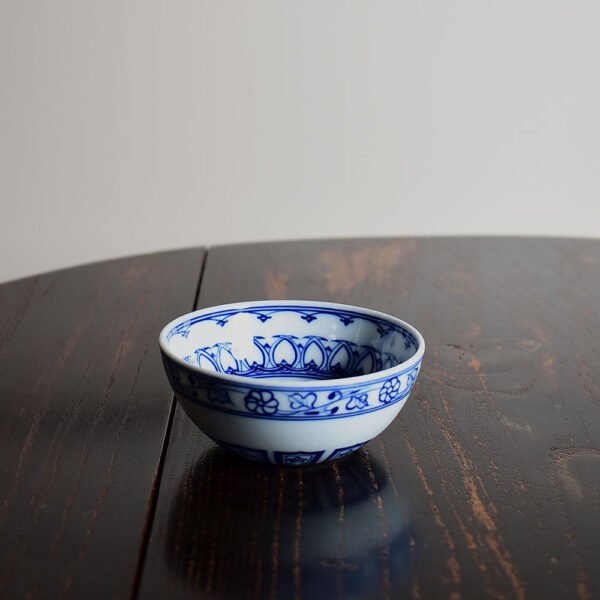
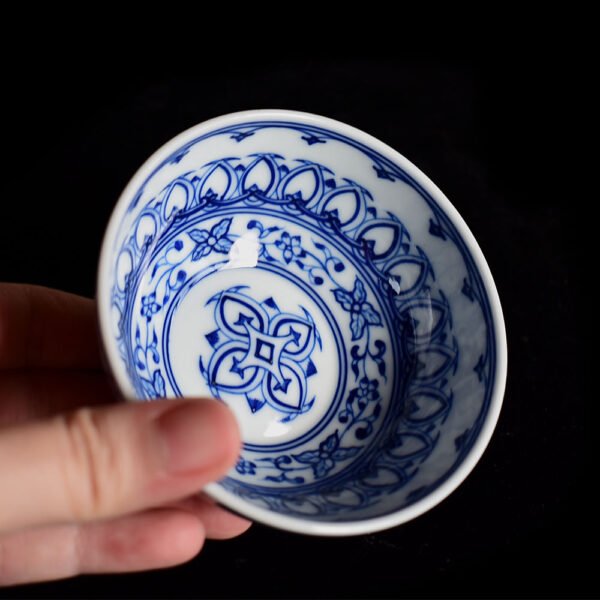 Out of Stock
$169.99
Out of Stock
$169.99This Baoxiang teacup is completely handmade and hand painted. The special craft used in this teaware includes Blue and white underglaze colour and underglaze red.
The pattern featured is called “Bao Xiang” in Chinese, which is a traditional decorative motif representing one of the auspicious three treasures (Bao Xiang flower, Money tree, and Treasure basin), prevalent during the Sui and Tang dynasties in China. Bao Xiang pattern is also known as ‘Bao Xian Hua’ or ‘Bao Lian Hua’. Its lines are clear, and the colour is serene and antique. The Bao Xiang pattern design of this teaware is neat, and complex but not messy, and the whole picture of it is full and rich in details.
In Chinese culture, the Bao Xiang pattern symbolizes auspiciousness and happiness, representing people’s aspirations for happiness. It is widely popular in the decoration of silk brocade, bronze mirrors, and porcelain, showcasing people’s pursuit of a better life.
This teacup features smooth and concise curves, combining the unique beauty of the Bao Xiang pattern, creating a visually appealing and enjoyable tea-drinking experience.
-
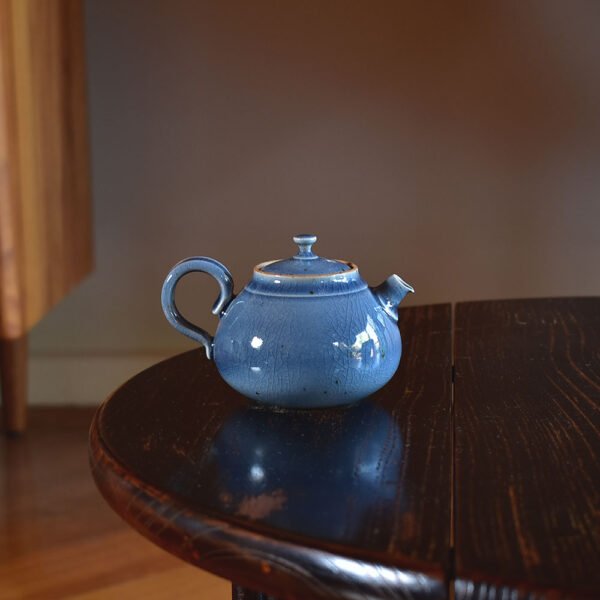
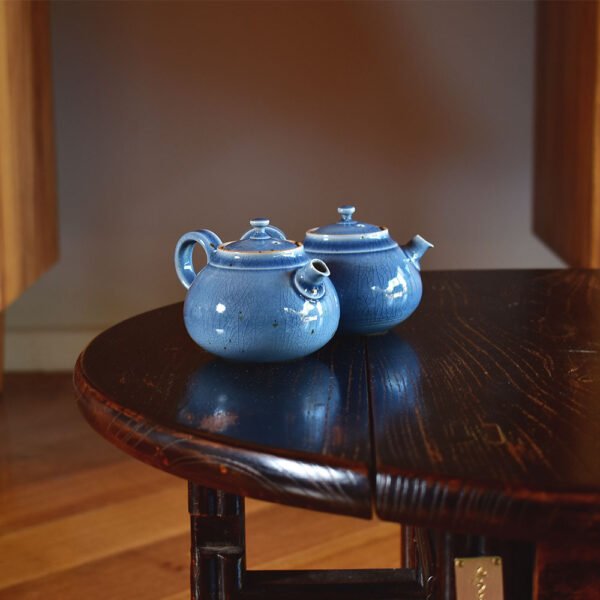 $135.99
$135.99This teapot is entirely handcrafted. It is covered with an after-rain sky blue and purple crackle glaze, presenting a beautiful blue-purple hue. The iron contained inside the clay creates unique decorative lines and iron spots during the firing process, decorating the surface of the vessel with scattered dot patterns, which exude a retro and elegant vibe. The unique-shaped spout of the teapot allows for a smooth and controlled water flow.
Besides that, the unique cracked glaze technique used creates beautiful patterns on the cup’s surface. Over time as it is soaked with tea soup, then resulting variations in the pattern make each piece truly outstanding and add more enjoyment to the tea-drinking experience.
Attention:
- Kiln-fired glaze variations are often unpredictable and can result in a wide range of colours from a single firing.
- The porosity of ceramics varies depending on the materials used, the recipe, the pressure applied, the duration of pressure, the thickness of the body, the firing temperature, and the duration of firing. Generally, the finer the porcelain, the smaller the pores, while the coarser the pottery, the larger the pores.
- Since porcelain is made from clay, the amount of iron spots present in the clay varies depending on the mineral content of the soil. These iron spots are harmless and do not affect the use of the porcelain. Removing them would require the use of chemical materials, which can be damaging to high-quality porcelain.
- Handmade products are not perfect, and each piece can have differences in size, shape, colour, and other aspects.
-
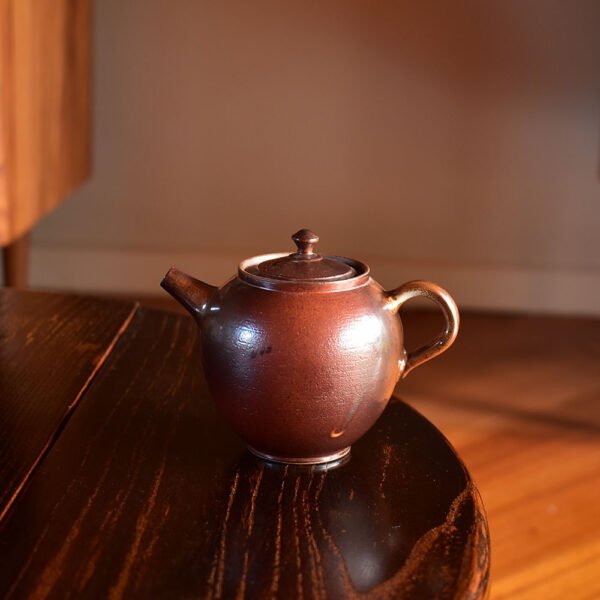
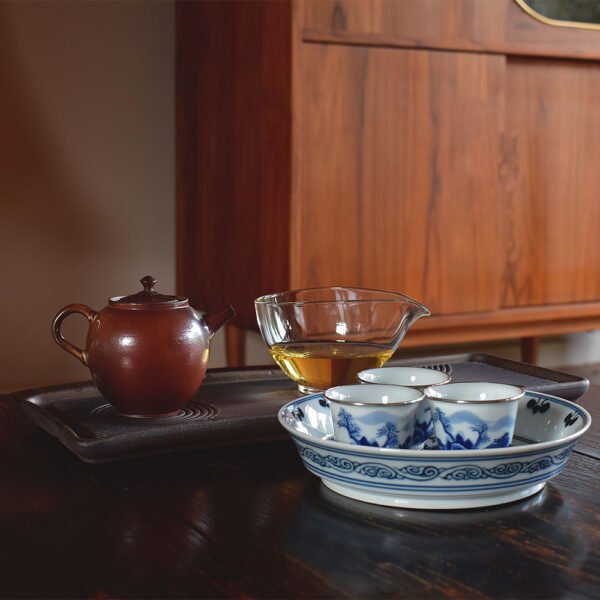 Out of Stock
$123.99[vc_row et_row_padding="true" el_class="p-variations"][vc_column width="1/3" offset="vc_col-xs-4"][et_image alignment="aligncenter" image="29756" extra_class="p-current"][/et_image][/vc_column][vc_column width="1/3" offset="vc_col-xs-4"][et_image alignment="aligncenter" image="29750" img_link="url:%2Fp%2Fhandmade-wood-fired-beauty-teapot-drop%2F"][/et_image][/vc_column][vc_column width="1/3" offset="vc_col-xs-4"][/vc_column][/vc_row]
Out of Stock
$123.99[vc_row et_row_padding="true" el_class="p-variations"][vc_column width="1/3" offset="vc_col-xs-4"][et_image alignment="aligncenter" image="29756" extra_class="p-current"][/et_image][/vc_column][vc_column width="1/3" offset="vc_col-xs-4"][et_image alignment="aligncenter" image="29750" img_link="url:%2Fp%2Fhandmade-wood-fired-beauty-teapot-drop%2F"][/et_image][/vc_column][vc_column width="1/3" offset="vc_col-xs-4"][/vc_column][/vc_row]Stoneware clay wood-fired teapots are handcrafted, which means that each piece is unique. And it has a unique beauty that comes from both the nature of the materials used and the firing process.
Stoneware clay is a type of ceramic clay that has a naturally earthy and organic appearance. It is often chosen by potters for its ability to give a warm and rustic feel to their work. When combined with the natural effects of wood-firing, the teapot can have a very distinct and beautiful appearance.
This unique teapot can be an impressive beauty and enjoyment when experiencing tea tasting ceremony.
-
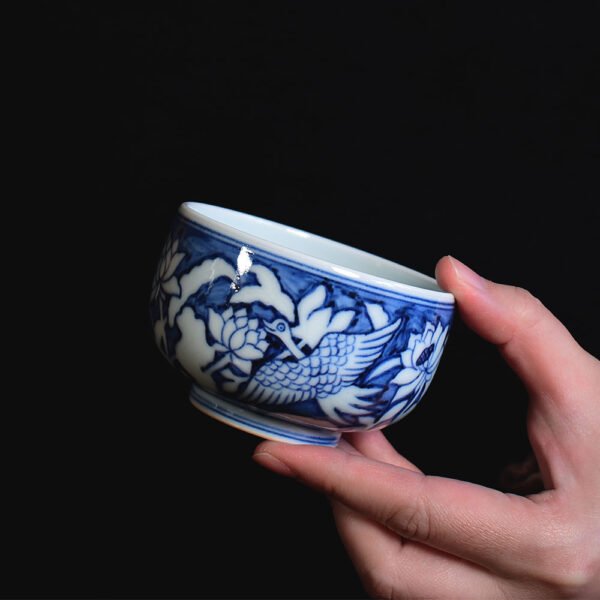
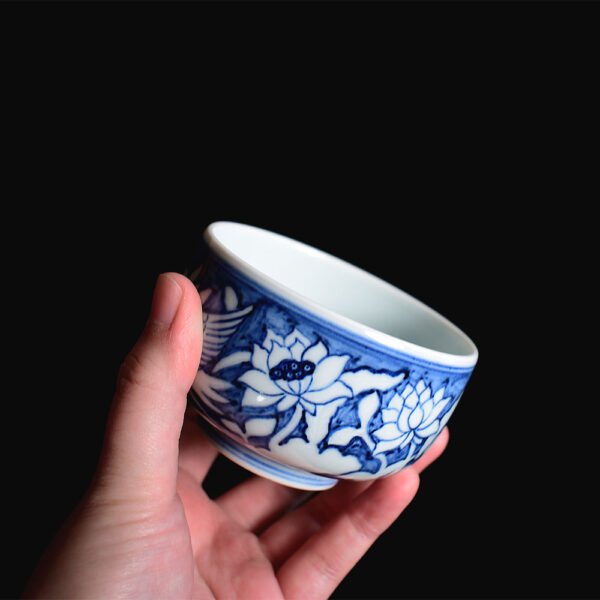 Out of Stock
$439.99
Out of Stock
$439.99This arhat teacup is made in the style of the Yuan dynasty blue and white porcelain, completely handmade and hand painted. The pattern of “一鹭莲科” or “一路连科” in Chinese culture is derived from the beautiful combination of the heron and lotus leaves. As “鹭” (heron) and “路” (path/road) have the same pronunciation, and “莲” (lotus) sounds like “连” (successive/continuous), the name “一路连科” is a play on words that conveys the beautiful meaning of the pattern. In ancient times, successive successful candidates in the imperial examinations were called “连科,” and “一路连科” is a good wish for students to have a smooth career path and achieve success step by step.
This teacup has a thick body and uses the Su Ma Li Qing glaze material (a kind of blue pigment) which reveals a unique charm of the past era. The entire production process is completed by hand, and every detail has been carefully designed and polished, giving this teacup a unique artistic charm.
-
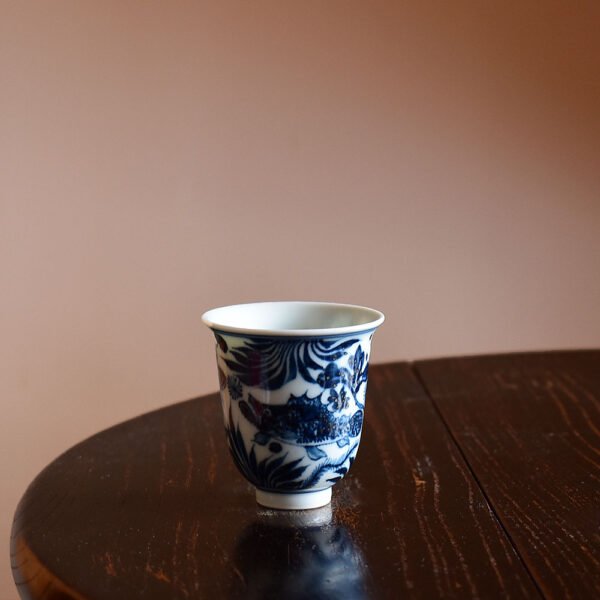
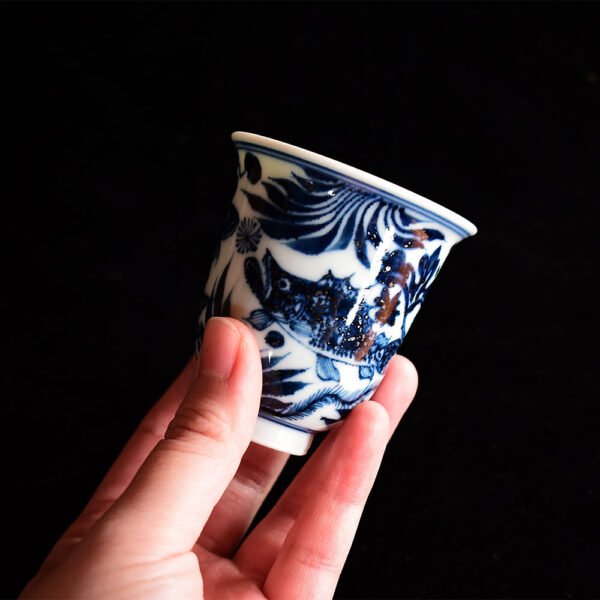 Out of Stock
$199.99
Out of Stock
$199.99This teacup is made in the style of the Yuan dynasty blue and white porcelain, completely handmade and hand painted. The blue and white fish & seaweed pattern is vivid, showcasing ancient cultural and aesthetic values, allowing people to immerse themselves in a beautiful artistic atmosphere while enjoying their tea.
The special pattern of this teacup is fish and seaweed. Since ancient times, fish and seaweed motifs have been traditional decorative patterns in ceramics, representing auspiciousness and carrying rich cultural and aesthetic meanings. The homophonic association between fish and the Chinese word for “surplus” (yu) makes fish a symbol of abundance and wealth. Fish motifs are often used to convey the meaning of “abundance and surplus,” “prosperity year after year” (as the pronunciation of fish is similar to that of “surplus” in Chinese), and “auspicious celebrations and abundance.” The fish and seaweed motifs typically feature fish as the central element, with additional decorations such as water plants, forming a variety of decorative patterns. The depiction of four swimming fish in the artwork symbolizes the concept of “surplus in all four seasons,” representing a year-round surplus, which carries a highly positive connotation. Such motifs are not only favoured by the royal court but also beloved by people from all walks of life as auspicious decorations. The flexible composition, auspicious symbolism, and abundant variations of fish and seaweed motifs have made them timeless classics throughout different eras.
For Yuan blue and white porcelain refers to the blue and white porcelain produced during the Yuan dynasty (1271-1368) in China. The Yuan dynasty was an important period in the history of Chinese porcelain and one of the peaks of Chinese porcelain art. As one of the representatives of that era, Yuan blue and white porcelain exhibited unique artistic styles and technical levels. The characteristic of Yuan blue and white is the use of cobalt blue pigment for painting, which is made of cobalt oxide. After firing, the colour is bright and rich, with an extremely high decorative effect. Yuan blue and white porcelain has various shapes, thick and heavy, concise, and fluent lines, and stable and solemn shapes, all made exquisitely.
The evolution of Yuan blue and white is based on the foundation of the Tang and Song celadon. Firstly, the glaze colour was improved and innovated. Unique white glaze, eggshell glaze and blue-white glaze were invented to make the glaze crystal clear. Cobalt pigment was imported for glaze colouring. Or using pigment made from domestic materials.
The formation of tin spots on Yuan blue and white is due to the high content of iron elements in local parts of the blue pigment. After reaching saturation in the high-temperature glaze solution and cooling down, the iron elements in the supersaturated part start to precipitate. If the iron content of the blue pigment is higher and the cooling rate is appropriate, tin spots are more likely to appear on the surface of the ware.
In addition to firing and materials, the formation of tin spots also involves the factor of glaze material. During the painting process, tin spots can also be formed due to the accumulation of blue pigment. Tin spots are more likely to appear on the surface of the ware at the intersections and the starting and ending points of brushstrokes. The formation of tin spots can be said to be a natural creation or an artificial decoration.
This teacup has a thick body and uses the Su Ma Li Qing glaze material (a kind of blue pigment), with a heavy sense of tin spots, revealing a unique charm of the past era. The entire production process is completed by hand, and every detail has been carefully designed and polished, giving this teacup a unique artistic charm. The blue and white fish & seaweed pattern is vivid, showcasing ancient cultural and aesthetic values, allowing people to immerse themselves in a beautiful artistic atmosphere while enjoying their tea.
-
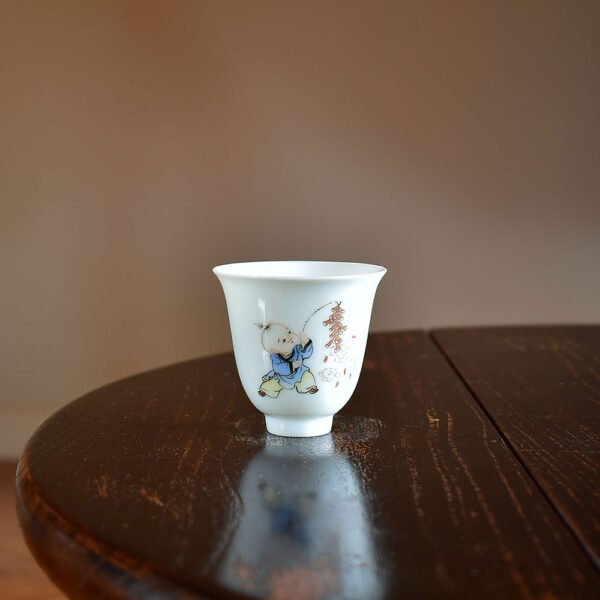
 $45.99
$45.99The teacup is made from high-quality white mud, giving it a smooth and elegant texture. The surface is covered in a lovely white glaze, which creates a beautiful and glossy finish. The cup is adorned with overglaze colours in two different patterns.
One of the patterns depicts children setting off firecrackers, a symbol of celebration and joy in Chinese culture. The other pattern shows a child with good fortune, representing prosperity and good luck. Both patterns are intricate and detailed, featuring vibrant colours that contrast beautifully against the white background.
Due to being entirely hand-painted, each painting has slight differences.
-

 $49.99
$49.99This handmade fair cup is adorned with a unique impressionistic Chinese ink landscape painting. Made from white jade ceramic, it has a smooth texture and a minimalist style that complements its elegant design. The fair cup maintains a sense of simplicity, making it perfect for enjoying a cup of tea in a calm and peaceful setting. Its smooth texture and minimalist style make it a pleasure to hold and admire, adding to its overall sense of tranquillity and refinement.
-
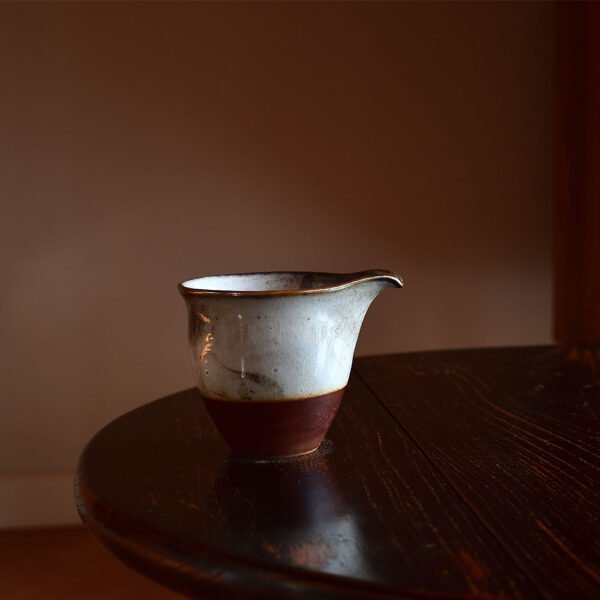
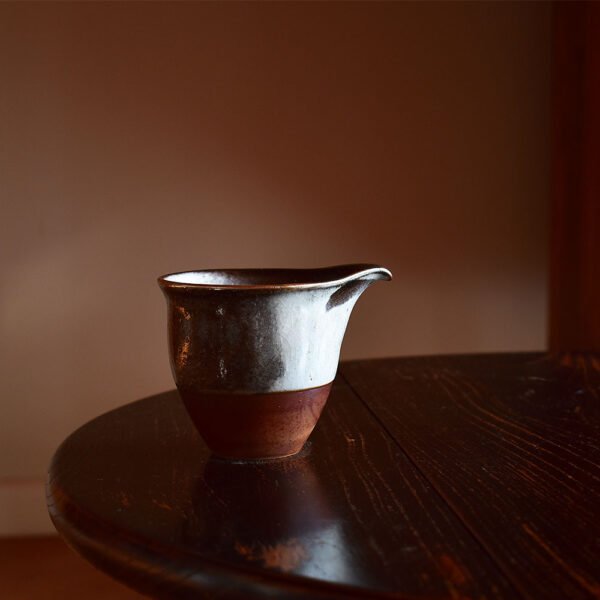 Out of Stock
$44.99
Out of Stock
$44.99This fair cup was baked with firewood and was made of both kiln-fired glaze variations and coloured & cracked glaze craft. Each one is unique and handmade – no two being exactly alike.
The overall design of this fair cup is simple and unsophisticated. The unique cracked glaze technique used creates beautiful patterns on the cup’s surface. Over time as it is soaked with tea soup, then resulting variations in the pattern make each piece truly outstanding and add more enjoyment to the tea-drinking experience.
Attention:
- Kiln-fired glaze variations are often unpredictable and can result in a wide range of colours from a single firing.
- The porosity of ceramics varies depending on the materials used, the recipe, the pressure applied, the duration of pressure, the thickness of the body, the firing temperature, and the duration of firing. Generally, the finer the porcelain, the smaller the pores, while the coarser the pottery, the larger the pores.
- Since porcelain is made from clay, the amount of iron spots present in the clay varies depending on the mineral content of the soil. These iron spots are harmless and do not affect the use of the porcelain. Removing them would require the use of chemical materials, which can be damaging to high-quality porcelain.
- Handmade products are not perfect, and each piece can have differences in size, shape, colour, and other aspects.
-

 $119.99
$119.99This fair cup has been wood ash glazed which gives it an earthy and organic feature. This glaze is often made by collecting the ash from burnt wood and mixing it with clay, creating a natural and rustic finish.
The unique shape created by the hand-pinching process gives the fair cup an individual character and charm. Each piece would be slightly different, with its own organic curves, asymmetries, and irregularities. These variations would make it even more special and add to its natural beauty.
Its natural and earthy appearance would evoke a sense of calmness and harmony, making it the perfect vessel for enjoying a warm cup of tea.
-
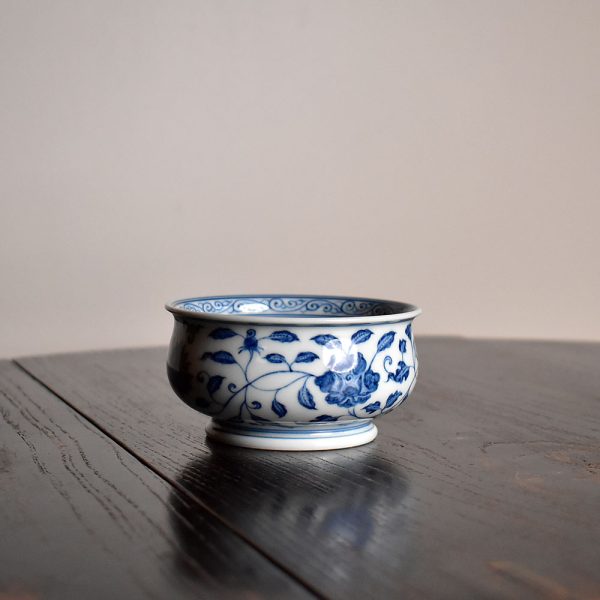
 $529.99
$529.99This teacup takes the classic form of a master’s master teacup with a censer-like profile. The rim flares slightly outward, the belly is full, and the foot ring is steady and well balanced. The overall lines are simple and dignified, lending an elegant presence on the tea table.
The outer wall is painted in blue and white with entwined lotus motifs, with branches and blossoms interwoven, symbolizing continuity and vitality. At the bottom of the interior lies a single lotus, its full bloom and spreading petals representing purity, integrity, and auspiciousness. This design approach of outer complexity and inner simplicity not only enhances its decorative beauty but also carries cultural meanings rooted in Confucian and Buddhist traditions.
The blue coloration is pure and refined, the contrast of blue and white crisp and harmonious, with a glossy and smooth glaze. Whether admired on a desk or used during tea gatherings, it reflects the taste and elegance of its owner.
As a master master teacup, it serves not only as the exclusive tea vessel signifying the host’s role in a tea setting but also as a symbol of etiquette and respect during refined gatherings.
-
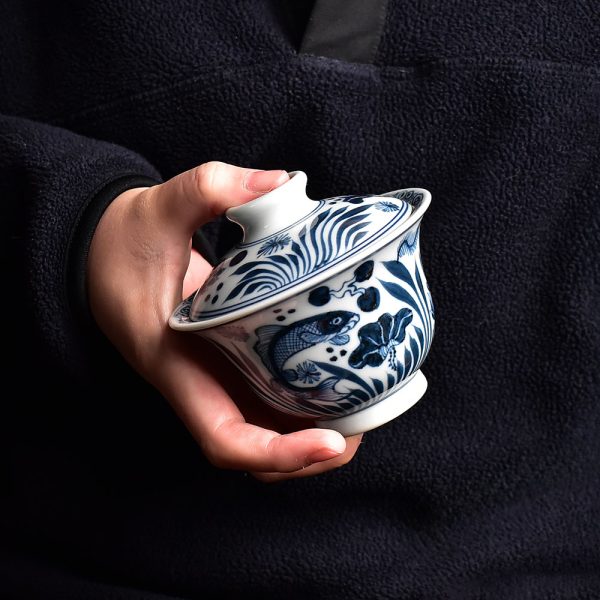
 $598.99
$598.99This Yuan-style blue and white fish-and-waterweed gaiwan is crafted using traditional Jingdezhen underglaze blue techniques. The body is sturdy, with a well-balanced form that exudes classical elegance. On the outer surface, vivid hand-painted carp swim gracefully among waving aquatic plants. The composition is lively and natural—the fish scales are delicately rendered, and the water plants sway in dynamic rhythm, revealing the artist’s refined brushwork and artistic finesse.
What sets this piece apart lies within: the interior of the gaiwan features an intricately incised design of fish and weeds, subtly hidden beneath the glaze. As light moves across the surface, the design gradually emerges like a submerged relief, as if the fish are gliding beneath the tea, adding a poetic and graceful charm to the tea experience.
The special pattern of this teacup is fish and seaweed. Since ancient times, fish and seaweed motifs have been traditional decorative patterns in ceramics, representing auspiciousness and carrying rich cultural and aesthetic meanings. The homophonic association between fish and the Chinese word for “surplus” (yu) makes fish a symbol of abundance and wealth. Fish motifs are often used to convey the meaning of “abundance and surplus,” “prosperity year after year” (as the pronunciation of fish is similar to that of “surplus” in Chinese), and “auspicious celebrations and abundance.” The fish and seaweed motifs typically feature fish as the central element, with additional decorations such as water plants, forming a variety of decorative patterns. The depiction of four swimming fish in the artwork symbolizes the concept of “surplus in all four seasons,” representing a year-round surplus, which carries a highly positive connotation. Such motifs are not only favoured by the royal court but also beloved by people from all walks of life as auspicious decorations. The flexible composition, auspicious symbolism, and abundant variations of fish and seaweed motifs have made them timeless classics throughout different eras.
For Yuan blue and white porcelain refers to the blue and white porcelain produced during the Yuan dynasty (1271-1368) in China. The Yuan dynasty was an important period in the history of Chinese porcelain and one of the peaks of Chinese porcelain art. As one of the representatives of that era, Yuan blue and white porcelain exhibited unique artistic styles and technical levels. The characteristic of Yuan blue and white is the use of cobalt blue pigment for painting, which is made of cobalt oxide. After firing, the colour is bright and rich, with extremely high decorative effect. Yuan blue and white porcelain has various shapes, thick and heavy, concise, and fluent lines, and stable and solemn shapes, all made exquisitely.
The evolution of Yuan blue and white is based on the foundation of Tang and Song celadon. Firstly, the glaze colour was improved and innovated. Unique white glaze, eggshell glaze and blue-white glaze were invented to make the glaze crystal clear. Cobalt pigment was imported for glaze colouring. Or using the pigment made from domestic materials.
The formation of tin spots on Yuan blue and white is due to the high content of iron elements in local parts of the blue pigment. After reaching saturation in the high-temperature glaze solution and cooling down, the iron elements in the supersaturated part start to precipitate. If the iron content of the blue pigment is higher and the cooling rate is appropriate, tin spots are more likely to appear on the surface of the ware.
In addition to firing and materials, the formation of tin spots also involves the factor of glaze material. During the painting process, tin spots can also be formed due to the accumulation of blue pigment. Tin spots are more likely to appear on the surface of the ware at the intersections and the starting and ending points of brushstrokes. The formation of tin spots can be said to be a natural creation or an artificial decoration.
This gaiwan has a thick body and uses the Su Ma Li Qing glaze material (a kind of blue pigment), with a heavy sense of tin spots, revealing a unique charm of the past era. The entire production process is completed by hand, and every detail has been carefully designed and polished, giving this teacup a unique artistic charm. The blue and white fish & seaweed pattern is vivid, showcasing ancient cultural and aesthetic values, allowing people to immerse themselves in a beautiful artistic atmosphere while enjoying their tea.
-

 $649.99
$649.99This teacup is made in the style of the Yuan dynasty blue and white porcelain, completely handmade and hand painted. The pattern of “一鹭莲科” or “一路连科” in Chinese culture is derived from the beautiful combination of the heron and lotus leaves. As “鹭” (heron) and “路” (path/road) have the same pronunciation, and “莲” (lotus) sounds like “连” (successive/continuous), the name “一路连科” is a play on words that conveys the beautiful meaning of the pattern. In ancient times, successive successful candidates in the imperial examinations were called “连科,” and “一路连科” is a good wish for students to have a smooth career path and achieve success step by step.
For Yuan blue and white porcelain refers to the blue and white porcelain produced during the Yuan dynasty (1271-1368) in China. The Yuan dynasty was an important period in the history of Chinese porcelain and one of the peaks of Chinese porcelain art. As one of the representatives of that era, Yuan blue and white porcelain exhibited unique artistic styles and technical levels. The characteristic of Yuan blue and white is the use of cobalt blue pigment for painting, which is made of cobalt oxide. After firing, the colour is bright and rich, with extremely high decorative effect. Yuan blue and white porcelain has various shapes, thick and heavy, concise, and fluent lines, and stable and solemn shapes, all made exquisitely.
The evolution of Yuan blue and white is based on the foundation of Tang and Song celadon. Firstly, the glaze colour was improved and innovated. Unique white glaze, eggshell glaze and blue-white glaze were invented to make the glaze crystal clear. Cobalt pigment was imported for glaze colouring. Or using the pigment made from domestic materials.
The formation of tin spots on Yuan blue and white is due to the high content of iron elements in local parts of the blue pigment. After reaching saturation in the high-temperature glaze solution and cooling down, the iron elements in the supersaturated part start to precipitate. If the iron content of the blue pigment is higher and the cooling rate is appropriate, tin spots are more likely to appear on the surface of the ware.
In addition to firing and materials, the formation of tin spots also involves the factor of glaze material. During the painting process, tin spots can also be formed due to the accumulation of blue pigment. Tin spots are more likely to appear on the surface of the ware at the intersections and the starting and ending points of brushstrokes. The formation of tin spots can be said to be a natural creation or an artificial decoration.
While this Lian Sheng Yuan Xi teacup retains the bold and rich coloration of classic Yuan blue and white porcelain, its tin-spot effect is relatively subtle, giving it a more delicate and refined appearance. The overall aesthetic is graceful and elegant, embodying a scholarly charm. Compared to the traditionally bold and unrestrained Yuan blue and white style, this piece leans towards a more understated and sophisticated aesthetic, blending classic heritage with a softer, more literary elegance. It brings a sense of warmth and refinement to any tea session, offering a harmonious balance between history and artistry.
-

 Out of Stock
$499.99
Out of Stock
$499.99This Gaiwan is meticulously handcrafted using the blue-and-white with underglaze red technique. The artwork features camellia flowers, symbolising passion and beauty, often used to convey auspiciousness and blessings for happiness.
Blue-and-White with Underglaze Red (commonly known as “blue-and-purple”) is a ceramic decorative method in which underglaze red designs are added to blue-and-white patterns. Blue-and-white refers to patterns drawn with cobalt oxide, covered with a transparent glaze, and fired at over 1200°C in a reduction atmosphere to produce the characteristic underglaze decoration. Underglaze red uses copper oxide as a colouring agent, painted directly on the clay body (or on clay coated with a transparent white glaze), then covered with a clear glaze. After being placed in a saggar and fired at 1250–1280°C in a strong reduction atmosphere, the high-valence copper is reduced to low-valence copper, creating vivid yet subdued red patterns.
In this technique, underglaze red can be used to decorate the spaces between blue-and-white patterns, resulting in the unique combination known as blue-and-white with underglaze red. This complex process creates a striking artistic effect where blue, red, and white colours complement each other.
The production of blue-and-white with underglaze red ceramics is extraordinarily challenging. Historically, some artisans risked financial ruin in their pursuit of this technique due to its complexity. The difficulty arises because the cobalt (blue) and copper (red) oxides require different reduction temperatures, making it exceptionally hard to control the process. This results in a low success rate, with issues such as “flying red,” where the red and blue merge or the colours become indistinct and blurry.
Despite these challenges, the combination of blue-and-white with underglaze red achieves an unparalleled artistic effect, where the interplay of blue, red, and white elevates the beauty of ceramics to new artistic heights. This Gaiwan exemplifies the mastery of this rare and sophisticated craft, making it a stunning and meaningful piece of art.
-

 $499.99
$499.99This Gaiwan is meticulously handcrafted using the Red Underglaze technique, a process known for its exceptional difficulty and low yield. Red Underglaze uses copper as a colorant, painted directly onto the white porcelain body in intricate patterns before being coated with a layer of glaze. During high-temperature reduction firing, the copper produces a striking red hue, giving this technique its name. The vibrant, rich red contrasts beautifully with the pure white porcelain, highlighting the unique texture and elegance of Red Underglaze craftsmanship.
The Gaiwan’s design features trailing lotus motifs, a classic Chinese decorative theme. Traditionally, the trailing lotus, known as the “Vine of Longevity” for its interwoven and continuous blooms, symbolizes prosperity and endless vitality. In Confucian culture, the lotus is a representation of truth, goodness, and beauty, as well as a sacred emblem in Buddhism. The phonetic similarity between “lotus” and “continuity” in Chinese further conveys a wish for enduring blessings and harmonious emotions. As an enduring element of traditional Chinese design, the trailing lotus combines cultural depth with artistic beauty, embodying purity, elegance, and timeless sophistication.
The Gaiwan is perfectly proportioned, featuring a rounded and full lid knob and a lip designed for a comfortable grip. The saucer base is adorned with traditional geometric patterns, adding a touch of classical charm.
This Red Underglaze Gaiwan is a rare blend of artistry and practicality. The precious Red Underglaze technique bridges ancient craftsmanship with modern aesthetics, creating a masterpiece where the deep, fiery red seems to dance like flames upon the pristine white porcelain. It radiates an aura of elegance and refinement, making it a truly exceptional piece.
-

 $299.99
$299.99This Stem Teacup is meticulously handcrafted using the blue-and-white with underglaze red technique. In tea culture, the stem cup symbolizes solemnity and elegance. When using a stem cup for tea tasting, the graceful motion of raising the cup evokes a sense of timeless charm, as if immersed in the serene ambiance of ancient traditions, adding a touch of ritual and intrigue to the tea experience. Besides that, the artwork features camellia flowers, symbolising passion and beauty, often used to convey auspiciousness and blessings for happiness.
Blue-and-White with Underglaze Red (commonly known as “blue-and-purple”) is a ceramic decorative method in which underglaze red designs are added to blue-and-white patterns. Blue-and-white refers to patterns drawn with cobalt oxide, covered with a transparent glaze, and fired at over 1200°C in a reduction atmosphere to produce the characteristic underglaze decoration. Underglaze red uses copper oxide as a colouring agent, painted directly on the clay body (or on clay coated with a transparent white glaze), then covered with a clear glaze. After being placed in a saggar and fired at 1250–1280°C in a strong reduction atmosphere, the high-valence copper is reduced to low-valence copper, creating vivid yet subdued red patterns.
In this technique, underglaze red can be used to decorate the spaces between blue-and-white patterns, resulting in the unique combination known as blue-and-white with underglaze red. This complex process creates a striking artistic effect where blue, red, and white colours complement each other.
The production of blue-and-white with underglaze red ceramics is extraordinarily challenging. Historically, some artisans risked financial ruin in their pursuit of this technique due to its complexity. The difficulty arises because the cobalt (blue) and copper (red) oxides require different reduction temperatures, making it exceptionally hard to control the process. This results in a low success rate, with issues such as “flying red,” where the red and blue merge or the colours become indistinct and blurry.
Despite these challenges, the combination of blue-and-white with underglaze red achieves an unparalleled artistic effect, where the interplay of blue, red, and white elevates the beauty of ceramics to new artistic heights. This stem teacup exemplifies the mastery of this rare and sophisticated craft, making it a stunning and meaningful piece of art.
-

 $299.99
$299.99This censer-style cup is handcrafted using the underglaze red technique. The shape is inspired by ancient censer designs, embodying a rich cultural heritage while showcasing a distinctive artistic beauty. The cup’s form features a simple and dignified tone, with smooth and natural lines. The rim gently flares outward, exuding elegance, while the body is rounded and well-balanced, providing a sense of visual harmony and comfort.
The beauty of the censer-style cup lies not only in its exterior design but also in the meticulous attention to detail and craftsmanship. The proportion of the rim is perfectly calibrated for a comfortable grip when drinking. The base slightly tapers inward, adorned with classic meander patterns, adding visual depth and incorporating the traditional Chinese cultural symbolism of “endlessness and continuity.”
Moreover, underglaze red is an exceptionally challenging technique, with a very low success rate. It uses copper as the coloring agent, with patterns directly painted onto the white porcelain body and then covered with a transparent glaze. During firing in a high temperature reducing flame, the copper elements produce a vivid red hue, giving the name “underglaze red.” The rich and vibrant red contrasts sharply with the pure white porcelain, highlighting the unique texture and beauty of the underglaze red.
The entire cup features intertwining lotus patterns as its main motif. In traditional symbolism, the intertwining lotus, known as “wan shou teng” (longevity vine), represents blessings and continuity due to its layered structure and endless growth. In Confucian culture, the lotus symbolizes purity, truth, and beauty, while also being associated with Buddhism. The Chinese word for lotus, “莲” (lián), is a homophone for “连” (continuity), expressing heartfelt wishes and good fortune. As part of traditional Chinese decorative motifs, the intertwining lotus has been passed down through generations, appreciated for both its aesthetic charm and cultural significance. The lotus embodies a sacred and pure elegance—beautiful without being flamboyant, refined without being ostentatious—making it a popular decorative element in everyday life.
This underglaze red censer-style cup is a treasure that perfectly integrates art and practicality. By utilizing the precious underglaze red technique, it harmoniously combines ancient craftsmanship with modern aesthetics. The deep red, reminiscent of dancing flames, shines brilliantly against the pure white porcelain, exuding an aura of nobility and sophistication.





